A Taste of Provence: Ancient History, Natural Beauty, and Wine in 6 Days
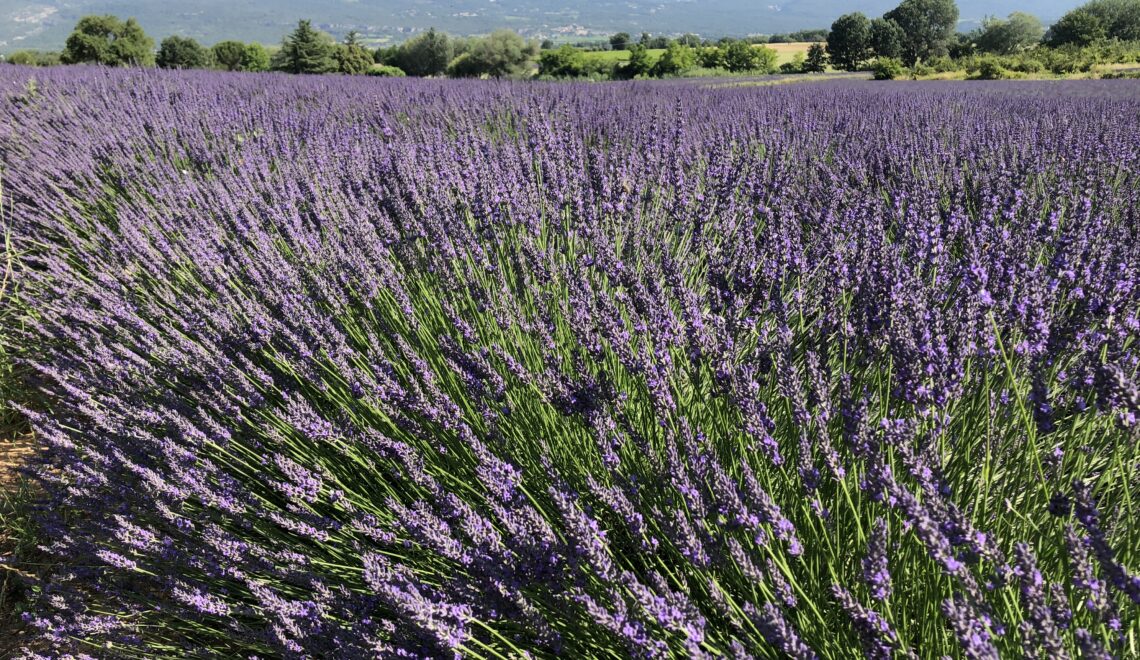
Provence is a large region in France, measuring more than 12,000 square miles. With mountains, the sea, Roman ruins, lavender fields, art, vineyards, markets, museums, and extraordinary history, it is all but impossible to see everything in one trip.
For this article, we focus on a trip based in the beautiful walled city of Avignon, in southeastern Provence. Avignon makes an excellent base both because it is a magnificent, fascinating city, and because it is a transportation hub. It is easily accessed by high-speed trains to and from other major French cities, and it is also central to many attractions in the region. It has two train stations. One is right in town next to the Tourist Office, and the other is the TGV station for high-speed trains, about 4 miles south of town (requiring a short taxi ride). Especially if you don’t have a car, Avignon is hard to beat as a base.
For us, Provence is a challenging place to drive. There are lots of VERY narrow streets, and some of the small towns are almost impossible to park/drive in. We prefer to rely on trains whenever possible, knowing we’ll also sometimes need to spring for a taxi or join a tour for transportation. On the other hand, many people would never visit Provence without a car. So take your pick!
Below are suggested activities for 6 full days in Provence, and they can be done in any order.
** Please note that this page contains affiliate links, meaning we may earn a very small commission if you book through them (at no extra cost to you).
Table of Contents
Day 1 – Explore Avignon
The ancient city of Avignon is the 5th largest in Provence. The historic center, where nearly all of the attractions are located, is quite walkable.
This place is just gorgeous. Every turn brings a new, narrow cobblestone road. Accordion players sit on the sidewalks. Flowers, art, cafés, music, and street performers abound. And ancient history is everywhere. Almost anywhere you walk, you’ll be within view of one of the 7 UNESCO World Heritage Sites within the walls of the city. In fact, the actual walls of the city, the ramparts, are a UNESCO site.
One of the best activities in Avignon is simply to wander the streets and explore all the hidden, scenic squares, and perhaps stop at a café and people-watch.
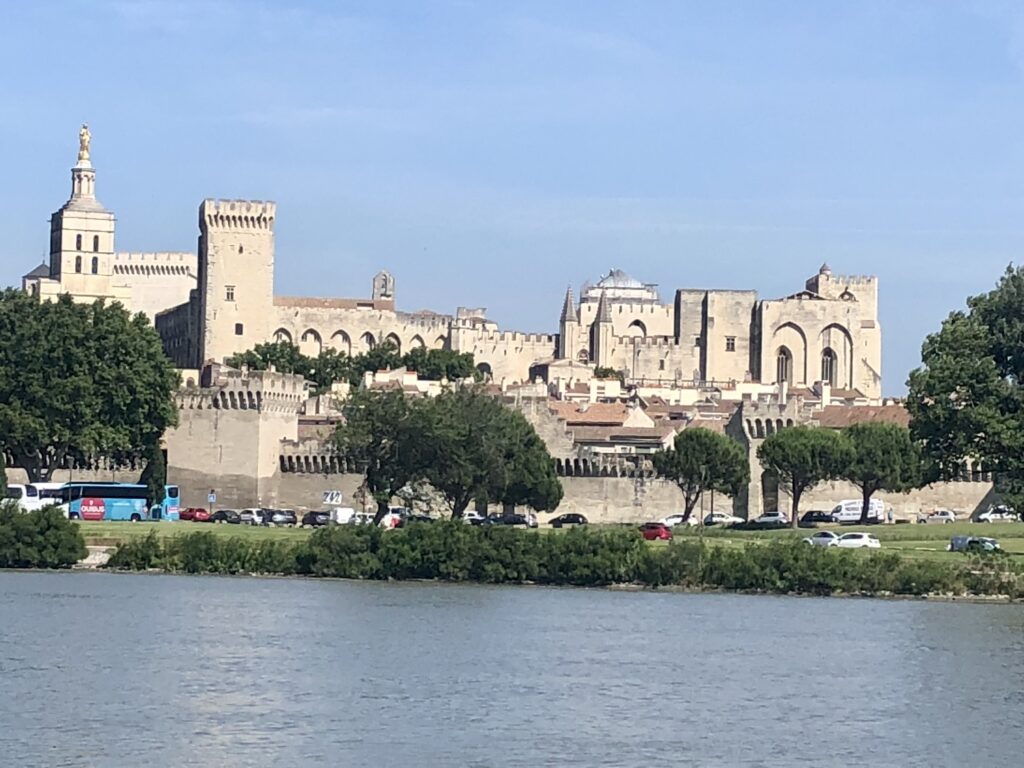
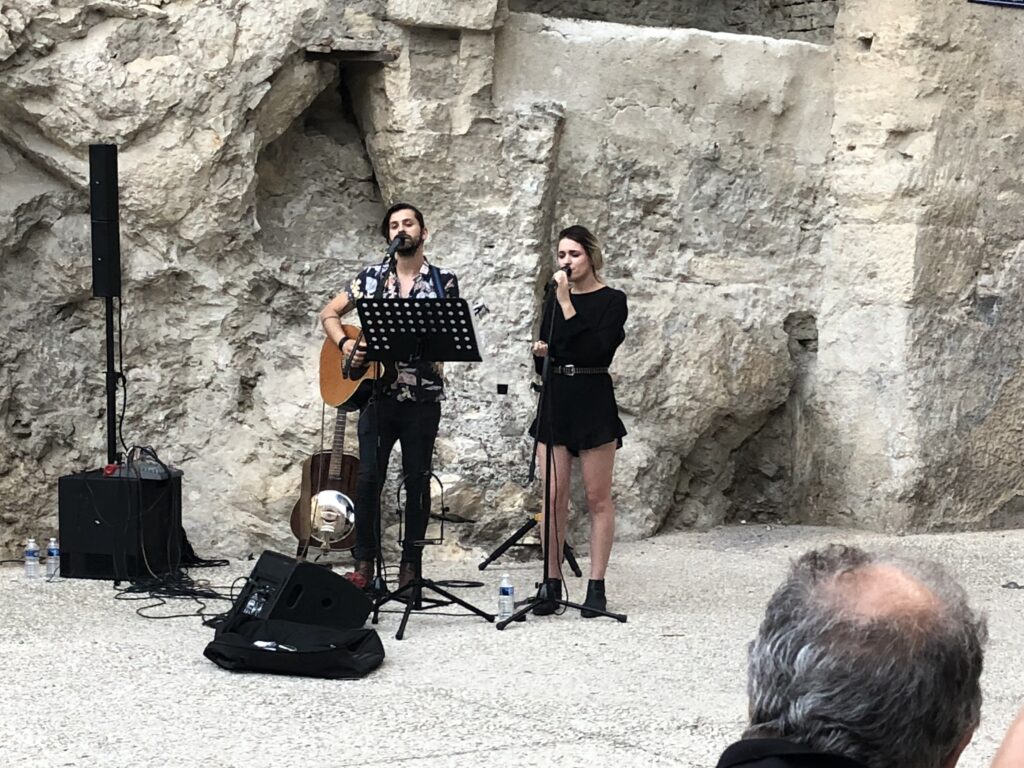
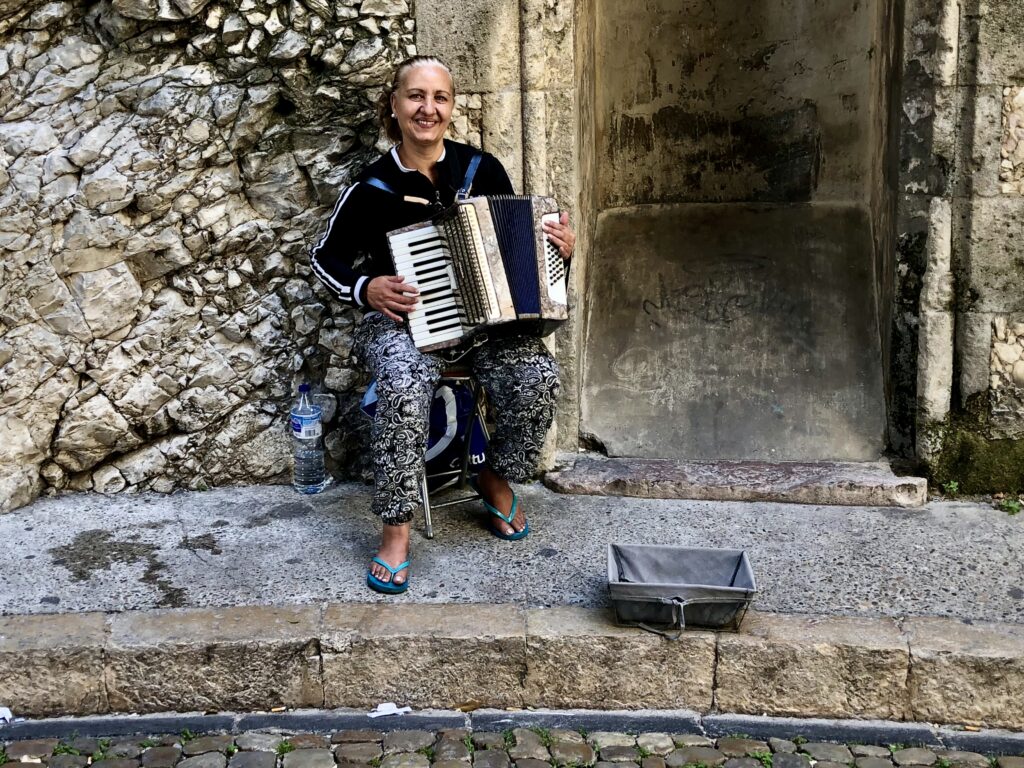
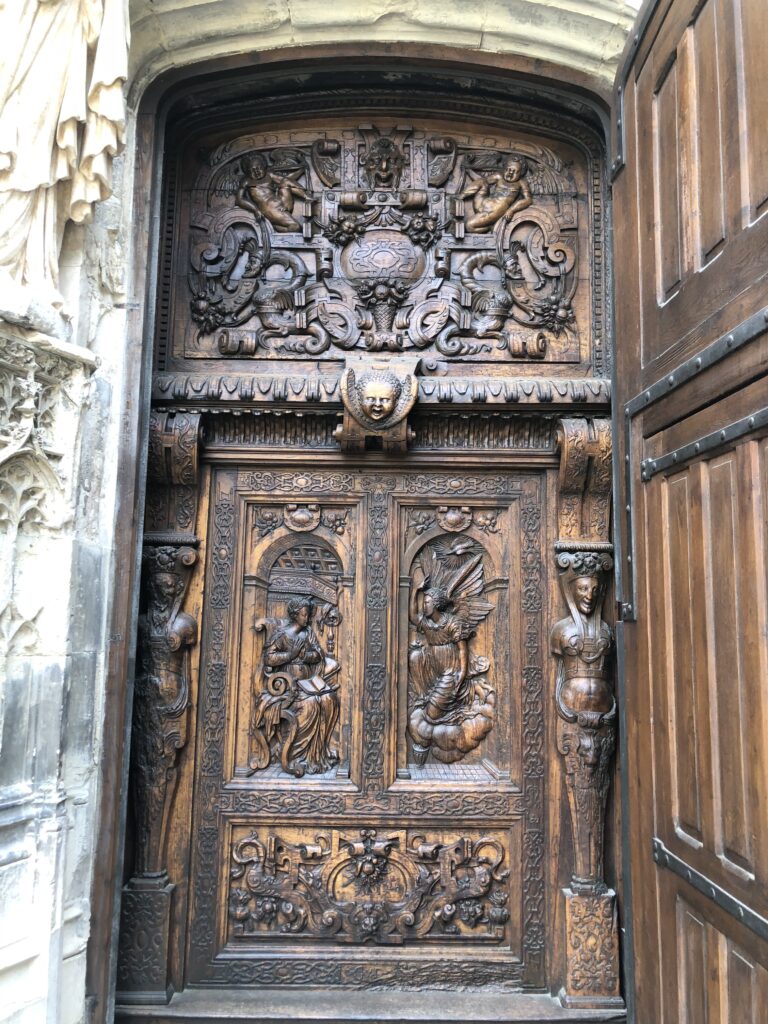
There is so much to see in Avignon, it is simply too much to include in this post. We’ve detailed the rest of the city’s sites in our companion post: An Unforgettable Day in Avignon.
Day 2 – Pont Du Gard
Pont du Gard is listed as the first excursion of the trip because it is so exceptional, it simply can’t be missed. (Technically, it is located just barely outside the Provence region limits, but it is considered to be part of the Provence experience.)
Pont du Gard is one of the best-preserved Roman aqueduct bridges in the world. It was built to carry water over 30 miles to the neighboring Roman colony of Nemausus, now known as Nîmes.
The Romans, two thousand years ago, used this and other aqueducts like it to irrigate their farms, provide what is basically indoor plumbing to the homes of wealthy citizens, provide drinking water and clean streets to cities, and, of course, extravagantly fill the famous Roman baths. It’s mind-boggling to think that this engineering feat existed 17+ centuries before indoor plumbing was common in the US or the rest of the world.
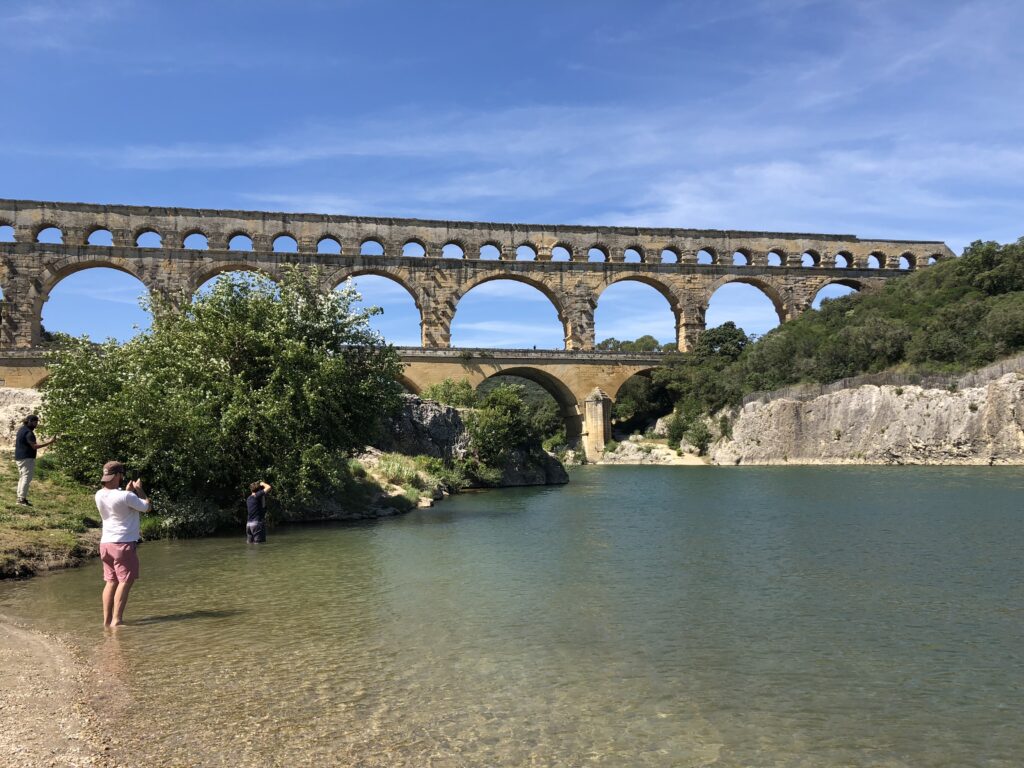
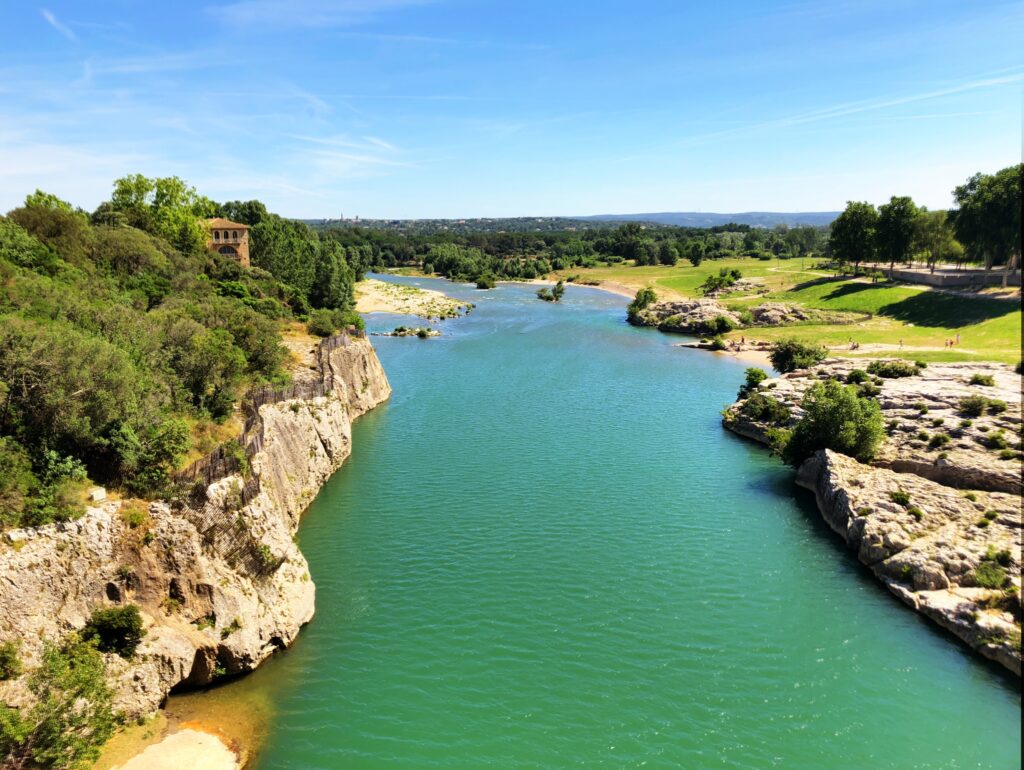
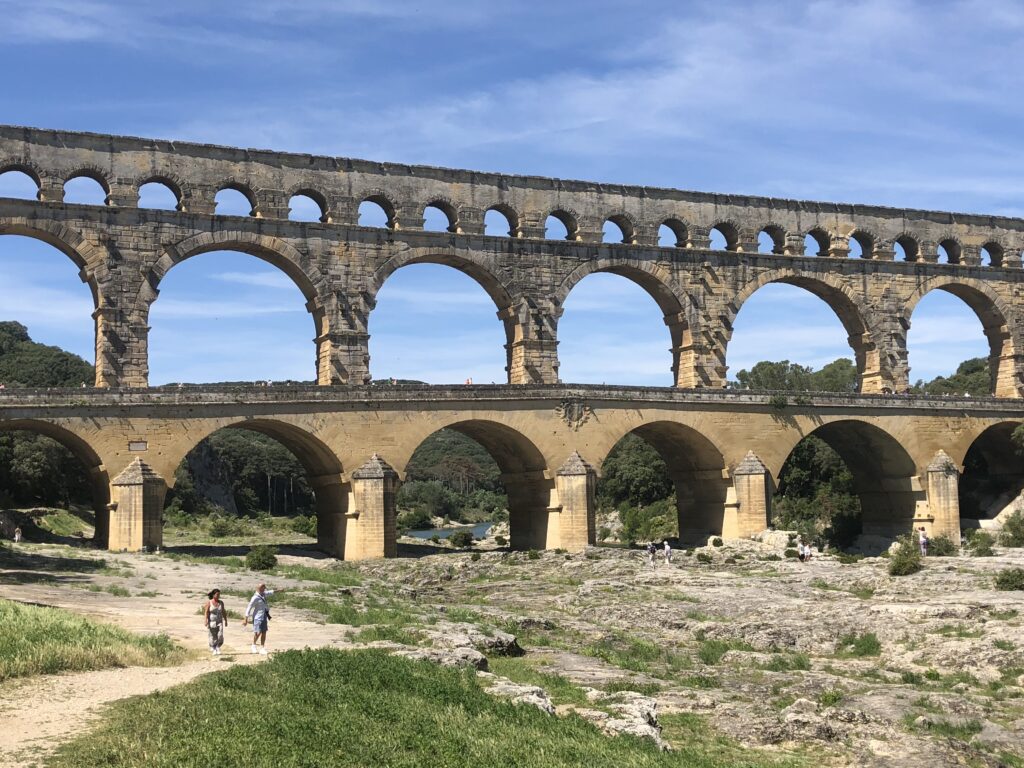
A picture may be worth a thousand words, but no photo can capture the overwhelming and nearly magical essence of this place. Just touching the ancient stone of the bridge is an experience.
In front of the aqueduct are three olive trees, donated by Spain, that are a thousand years old. They were thought to have perished after a hard freeze in the 1950s, but a few years later they bounced back. They still produce olives today.
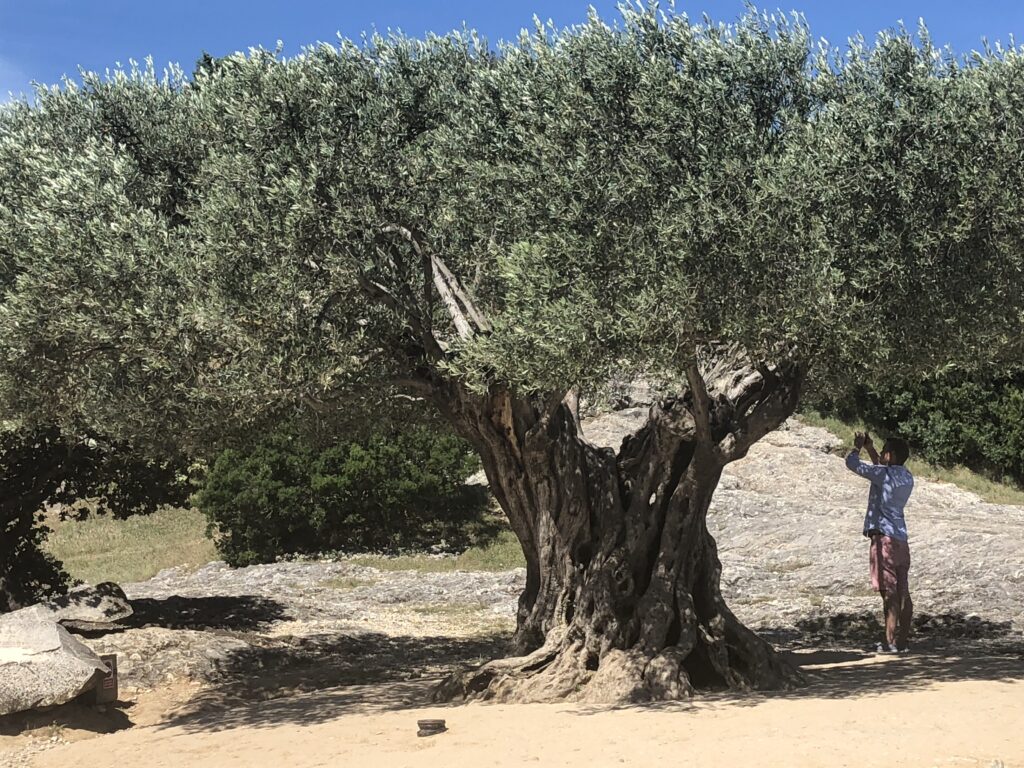
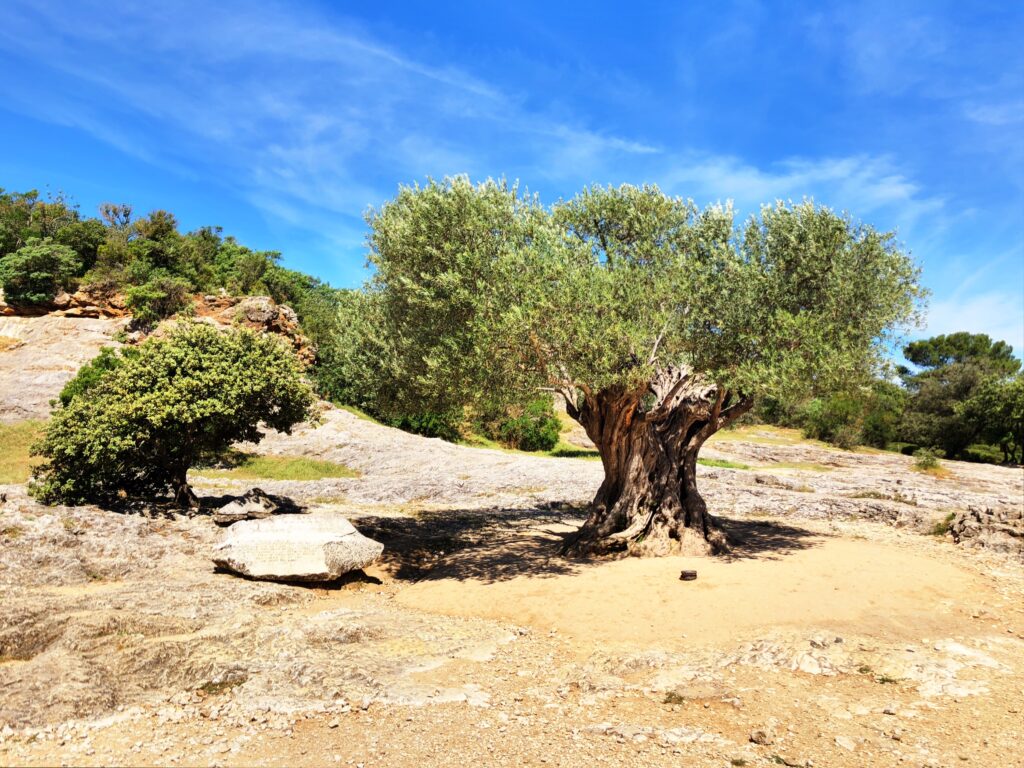
The Pont du Gard is located in a picturesque park, painstakingly preserved. There are biking and hiking trails all around, as well as opportunities to canoe, kayak, or even just float on one’s back underneath the aqueduct. That is, if you can pull yourself away from staring at the bridge. It is an unforgettable place, and it would be easy to spend a full day there. If you are there on a summer evening, a sound and light show is offered.
Pont du Gard is, unfortunately, not serviced by train. Without a car, the best ways to get there from Avignon are to hire a taxi (25 minutes each way), take an organized tour, or take the 55-minute bus ride (schedules vary by day and season).
Day 3 – Arles
Just an easy 18-minute train ride from Avignon is the wonderful city of Arles. Upon arrival, the city might feel a tad bit… gritty. Compared to the very refined Avignon, anyway.
But worry not, within a half-hour, you’ll be trying to figure out how to fit in a second day, and musing about moving there someday.
Located just south of Avignon along the Rhone River, Arles is a small city with a population of just over 50,000 people. Aside from being a picturesque, friendly, walkable city with museums, cute cafés, and great restaurants, it also has two huge claims to fame.
First, is the legacy of Dutch artist Vincent Van Gogh, who lived in Arles for just over a year of his difficult life. But during that time, he fell in love with Provence, and specifically Arles, and had an artistic breakthrough. He produced more than 200 paintings, including some of his most famous.
Arles is also where he suffered a tragic psychotic episode and cut off his own ear. Van Gogh was admitted to the Arles hospital (now Espace Van Gogh Cultural Center), which had a beautiful courtyard that inspired him. He praised the healing treatments he received there, and continued his art, completing two well-known paintings while he was a patient, Hospital in Arles and Garden of the Hospital.
After multiple stays in the hospital, Van Gogh continued to decline and to act erratically, leading a group of Arles residents to object to “the redheaded madman”. Van Gogh then left Arles to voluntarily commit himself to the Saint-Paul-de-Mausole mental asylum in nearby Saint-Rémy-de-Provence. Within the asylum he was able to have a studio where he produced some of his most celebrated paintings, continuing the most artistically successful three years of his life.
An excellent way to follow Van Gogh’s life in Arles is to follow the self-guided Van Gogh pedestrian path. The path leads visitors through a series of Van Gogh sights including 10 steel easels, each of which displays a copy of one of his paintings, each located in the spot in the city that motivated the painting, including the hospital, where guests can wander through the well-cared-for courtyard. Famous painting sites in addition to the hospital include Yellow House, Café Terrace at Night, and Starry Night Over the Rhône.
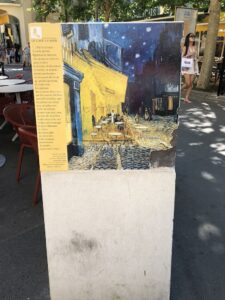
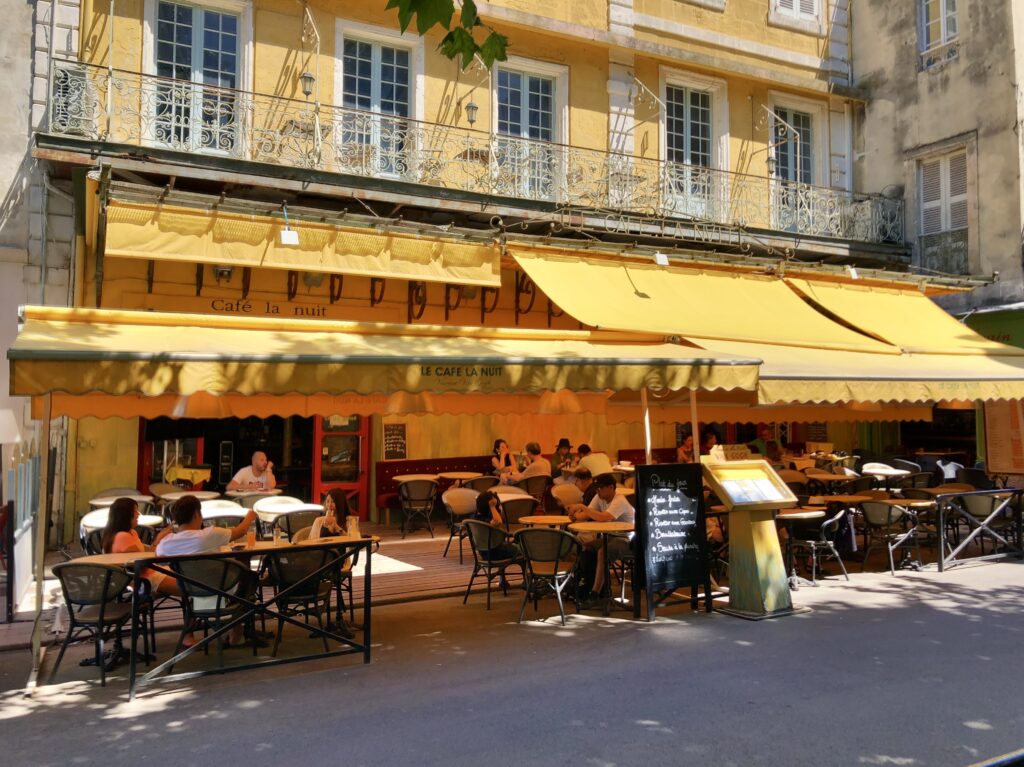
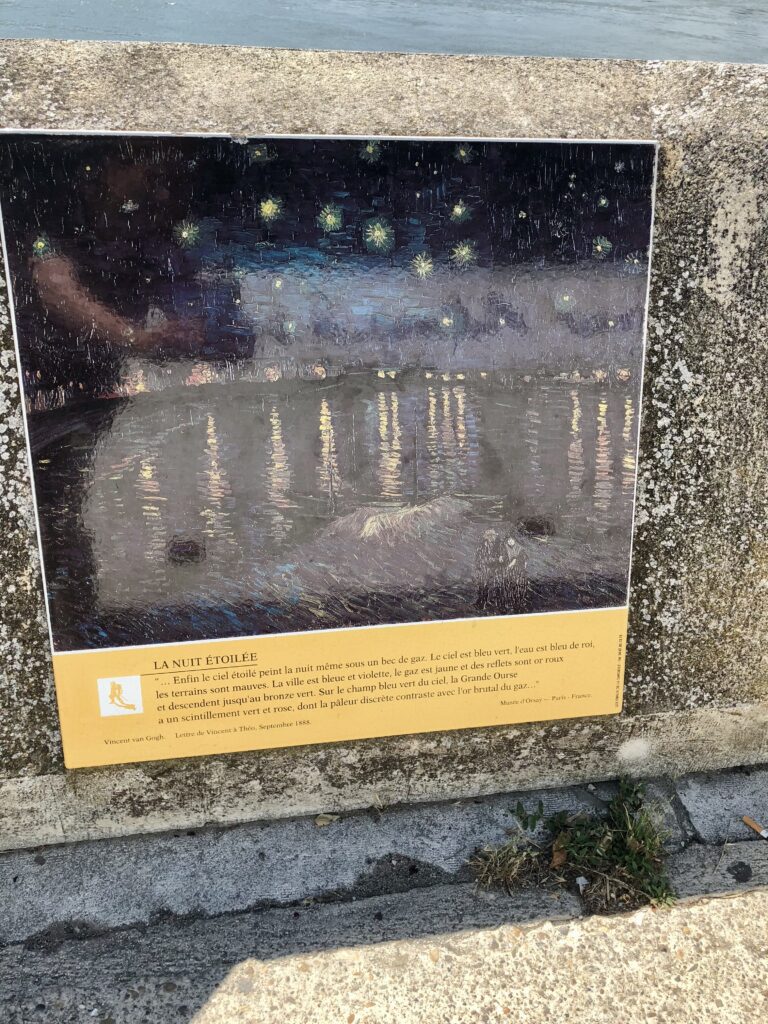
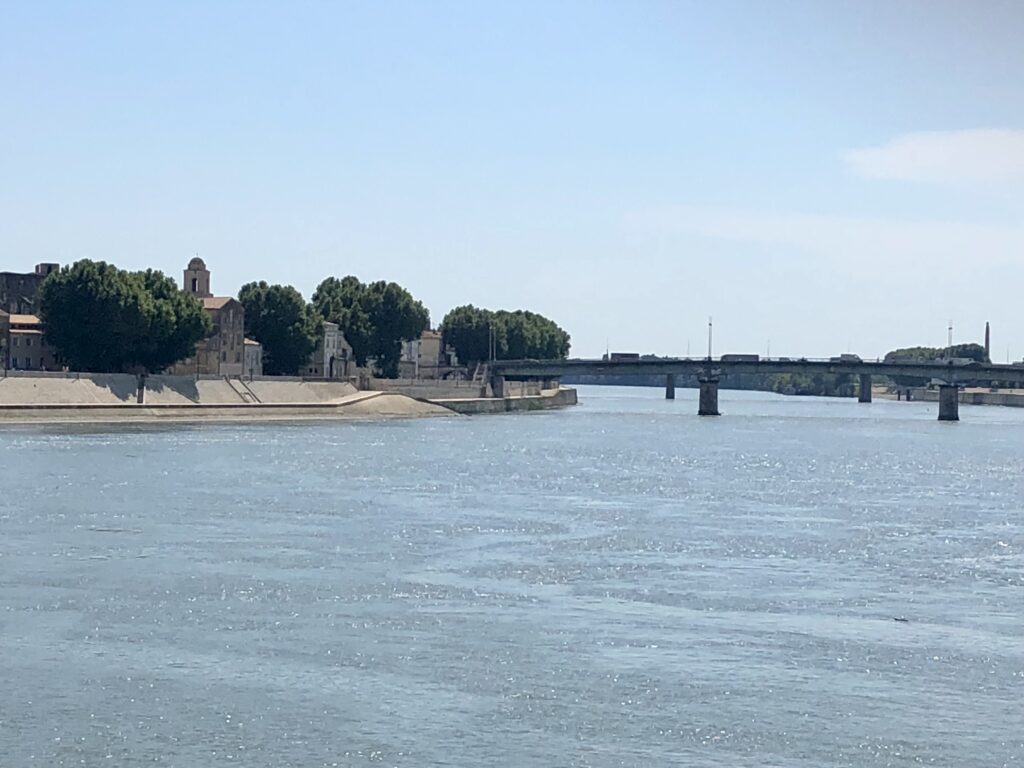
The second claim to fame for Arles is its stunning Roman ruins, which are UNESCO World Heritage sites.
The enormous Arles Amphitheater, built in about 90 AD, once seated 20,000 people who generally gathered to watch chariot races, theater productions, and gladiators fighting wild animals and each other (sometimes to their death). Today, it hosts bullfights in the summer – a gentle type of fighting in which the bulls are not injured.
The arena is amazingly well preserved, and visitors can walk among 60 archways on each of two levels, along with dozens of passageways. There are outstanding views over the city from the top level. (Be prepared for a lot of steps!)
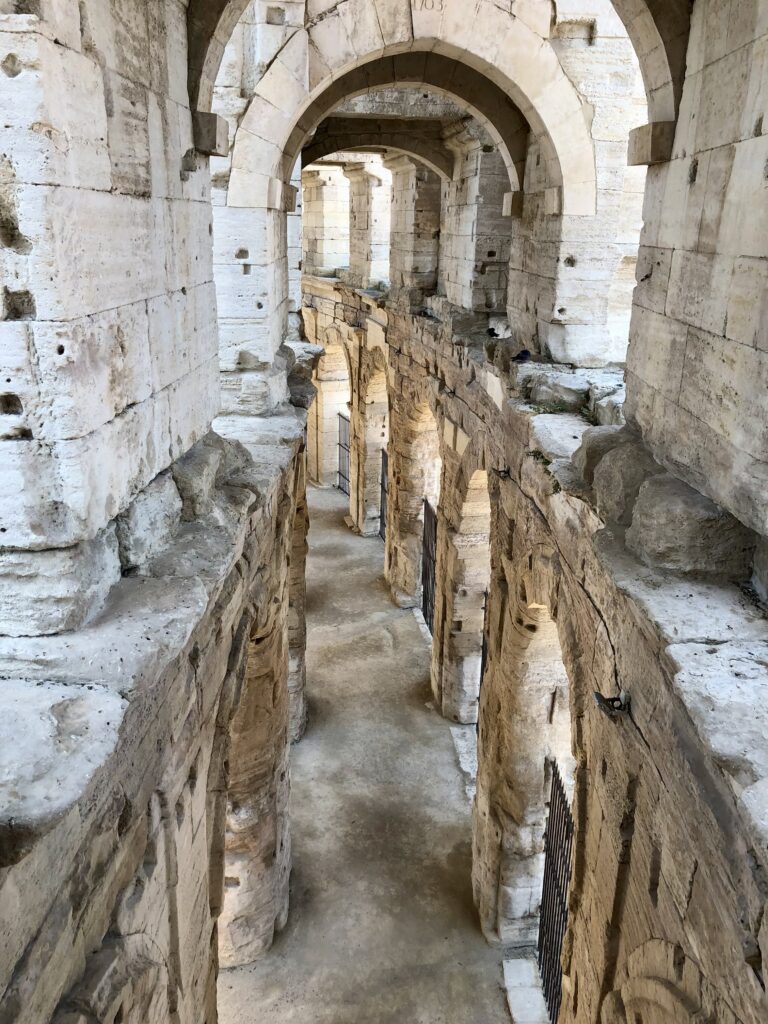
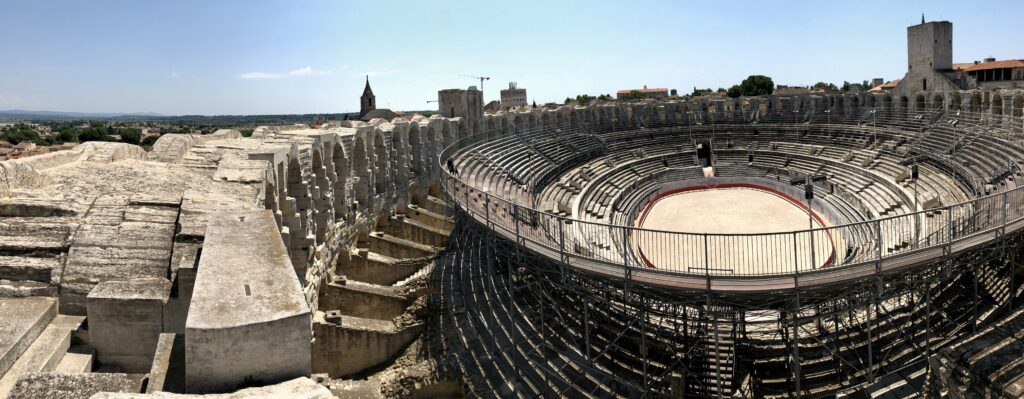
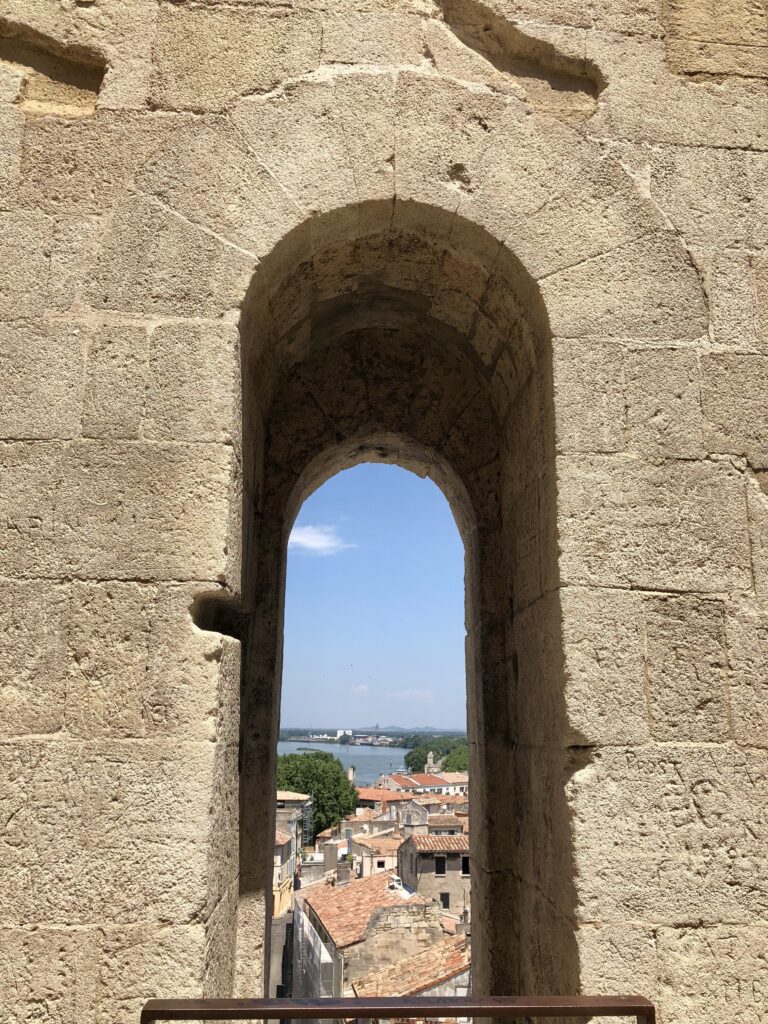
The nearby Théâtre Antique was built in roughly 12 AD. Sadly, it did not fare as well as the arena, and only pieces of the walls and stages remain. Despite the crumbling ruins, concerts continue to take place there each summer.
For those wanting to explore more ancient ruins in Arles, additional nearby sites include the cryptoporticus, a series of tunnels underneath what is now City Hall, and the Baths of Constantine, 4th-century public baths, which were fed by aqueducts.
After walking the Van Gogh path and exploring the ruins, as well as eating lunch at one of the adorable cafés in the old town, Arles still has more to offer:
St. Trophime Church is a stop on the ancient pilgrimage route to Santiago de Compostela in northwest Spain. For 800 years, pilgrims on their way to Santiago have been stopping here – they still do. The exquisite Romanesque exterior is enough of a reason to visit on its own. Inside, the Gothic-style church is adorned with paintings, tapestries, and statues.
Foundation Van Gogh, which opened in 2010, is an art museum dedicated to the legacy of Van Gogh, featuring works by contemporary artists in tribute to him. There are also rotating original works, painted by Van Gogh during his time in Provence.
Jardin d’Ete is located near the Théâtre Antique and is a great place to take a break during all your walking. It features shaded benches, paths, exotic trees, and dramatic sculptures.
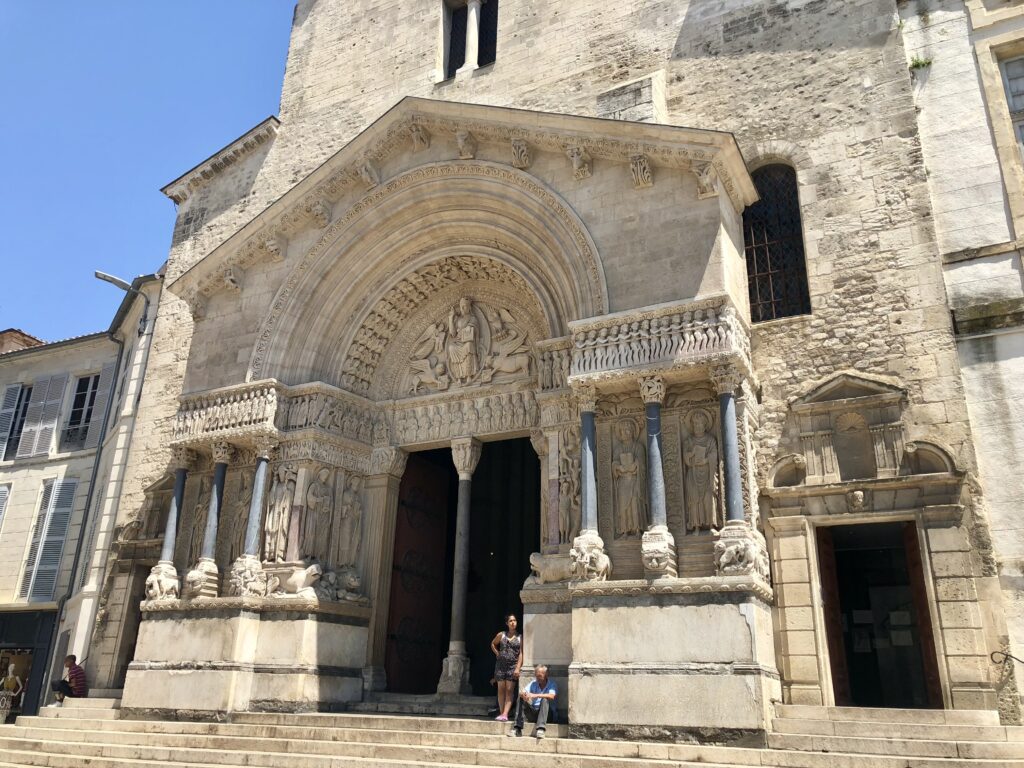
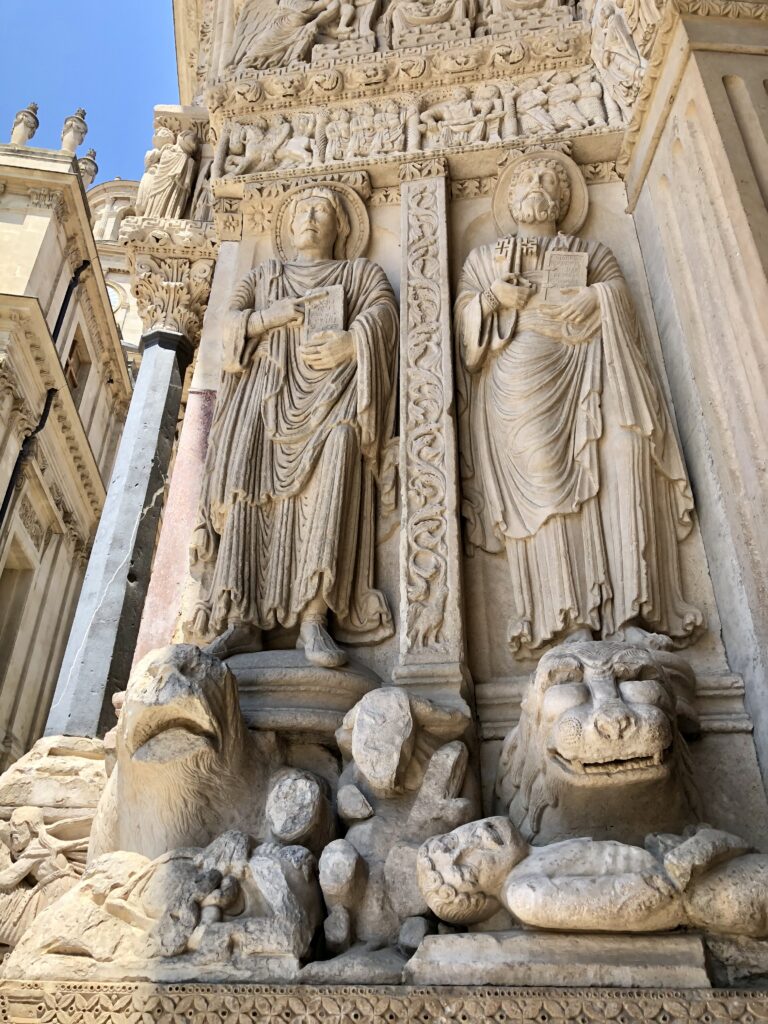
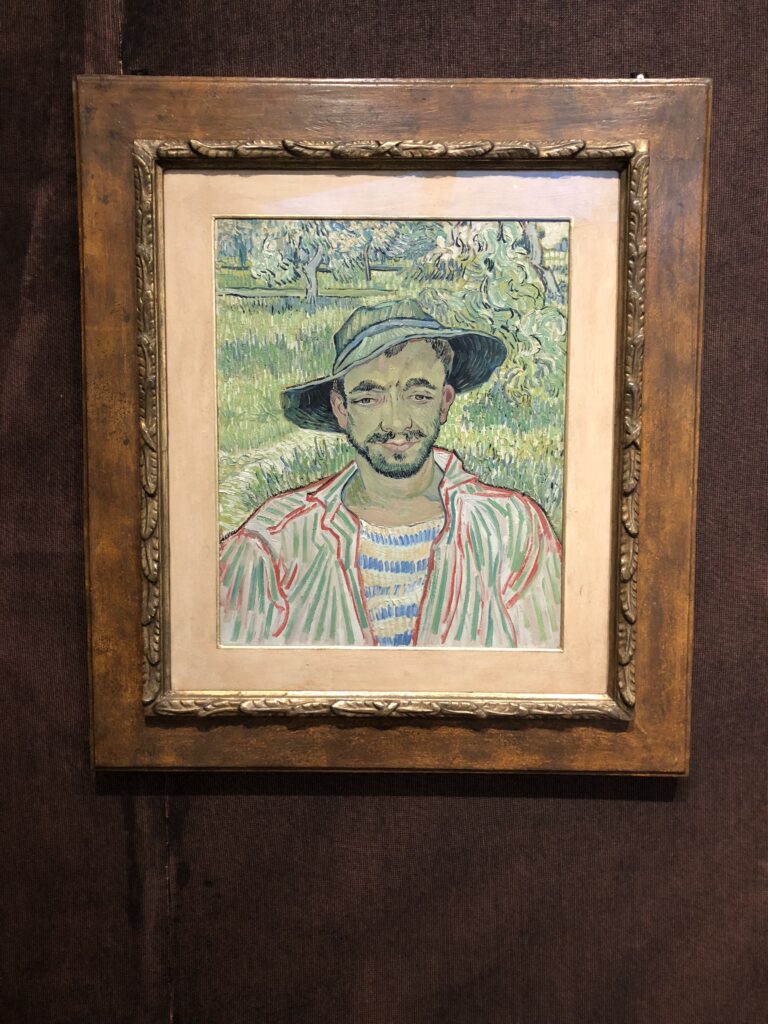
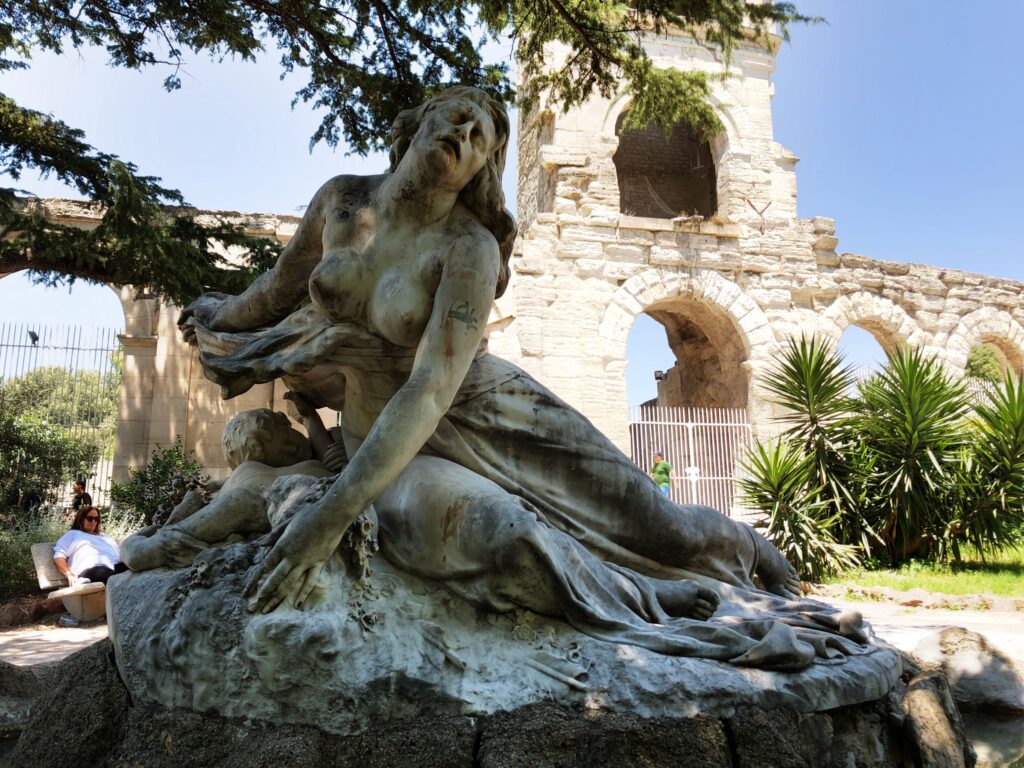
When you’ve had your fill of Arles (for now anyway), hop on one of the quick, frequent trains back to Avignon.
Day 4 – Lavender Fields and Hilltop Villages
Say “Provence”, and for most people, lush fields of lavender come to mind. If you are in Provence in the late spring and summer, a visit to these fields is a must. The Luberon area to the east of Avignon is one of the best areas to experience them. However, different fields peak at different times. (The higher the altitude, the later the bloom.) With a car, you can drive in search of the fields. One good resource is the Provence Tourism Board.
However, nature does not always perform on schedule! Taking a private or small group tour with a reputable guide who lives and works in the area is an excellent way to ensure you see lavender in full bloom. Local guides share information and are privy to information about fields that would be nearly impossible to find on your own. (When selecting a tour, we recommend a full-day tour that includes time for lunch and exploring the hilltop villages, described below.)
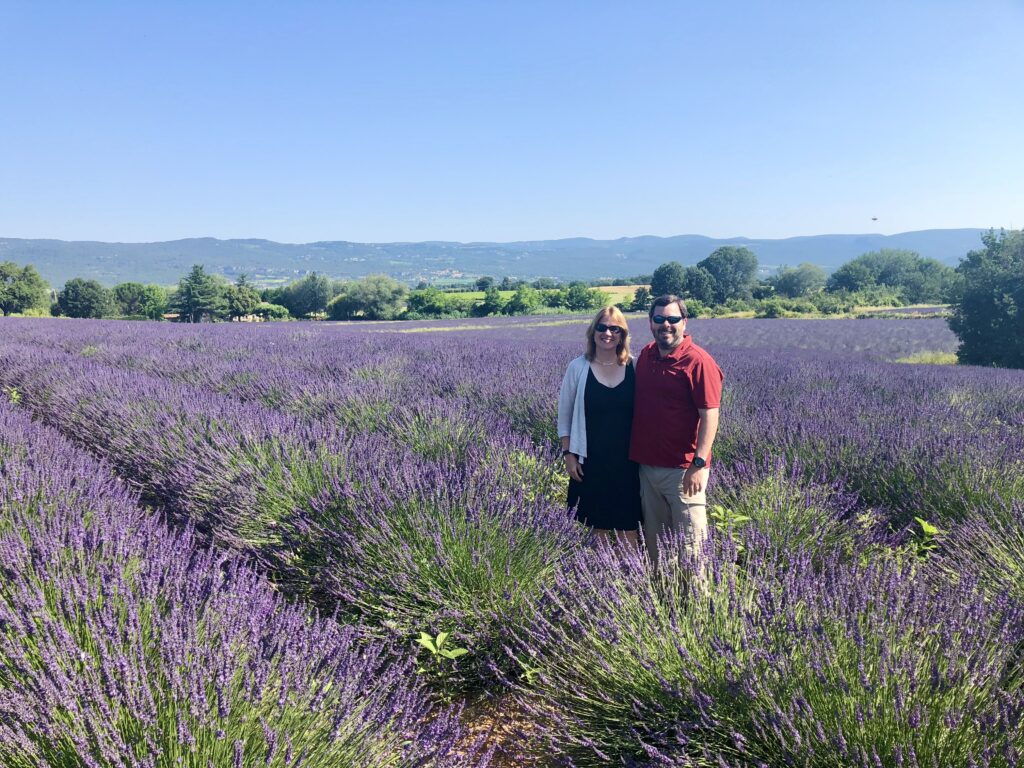
Lavender is the thing here. At every turn all over Provence, there are photos and paintings of lavender, soaps, lotions, food, ice cream, and almost anything else you can think of, made with lavender. But honestly, it can’t be oversold. The lavender fields are…hypnotic. Standing next to a field, smelling that intoxicating aroma, is an extraordinary experience. To top it all off, the entire region is surrounded by mountains, making it even more spectacular.
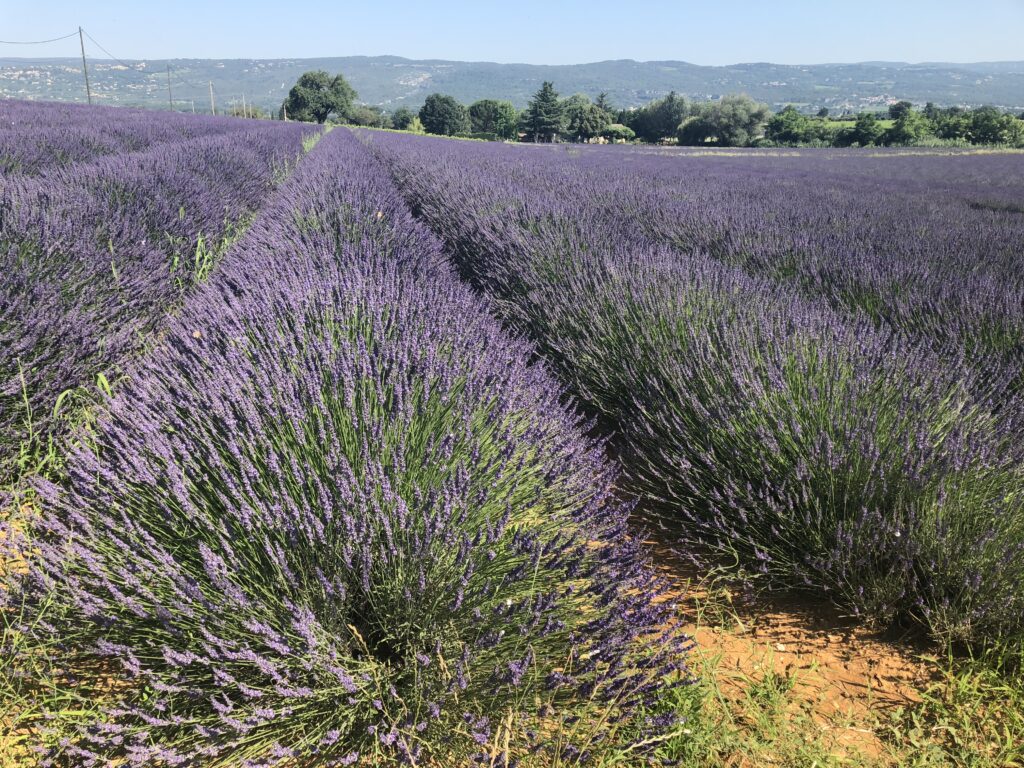
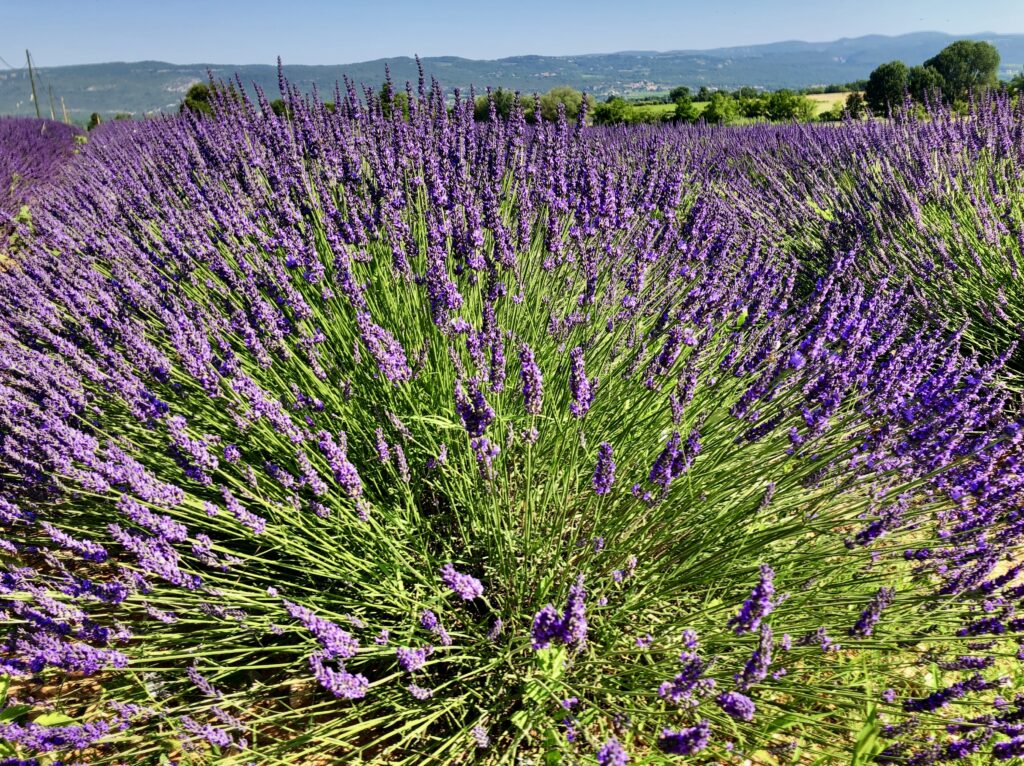
The Luberon is also well known for its breathtaking hilltop villages, with each one claiming to be the most beautiful. (We find it hard to choose!) Either in your own car or with your tour, driving through the area’s vineyards and orchards, and spending some time at a few of these villages is a “can’t-miss” experience in Provence.
In 1989, Peter Mayle published his now-famous book, A Year in Provence, detailing the humorously recounted joys and frustrations of a British couple re-locating to the hilltop village of Ménerbes in The Luberon.
It re-ignited an interest in these picturesque villages. Reading the short, light-hearted book before visiting Provence is a great way to prepare for the trip.

Perched on the sides of mountains in the French Prealps, (just west of the Alps), these villages are a photographer’s dream, and delightful to explore. Like Provence in general, the pace of life is relaxed here, perhaps even a bit more relaxed than the rest of the region.
Though similar in some ways, each village has its special charm. Attractions include intimate but casual restaurants with just a few tables that are attended to by the chef, art studios with the artist present, historic yet un-crowded churches, castles, and other ancient sites, quaint markets, bars and cafés with unexpected patios featuring stunning mountain views, limestone and ochre cliffs, and friendly residents.
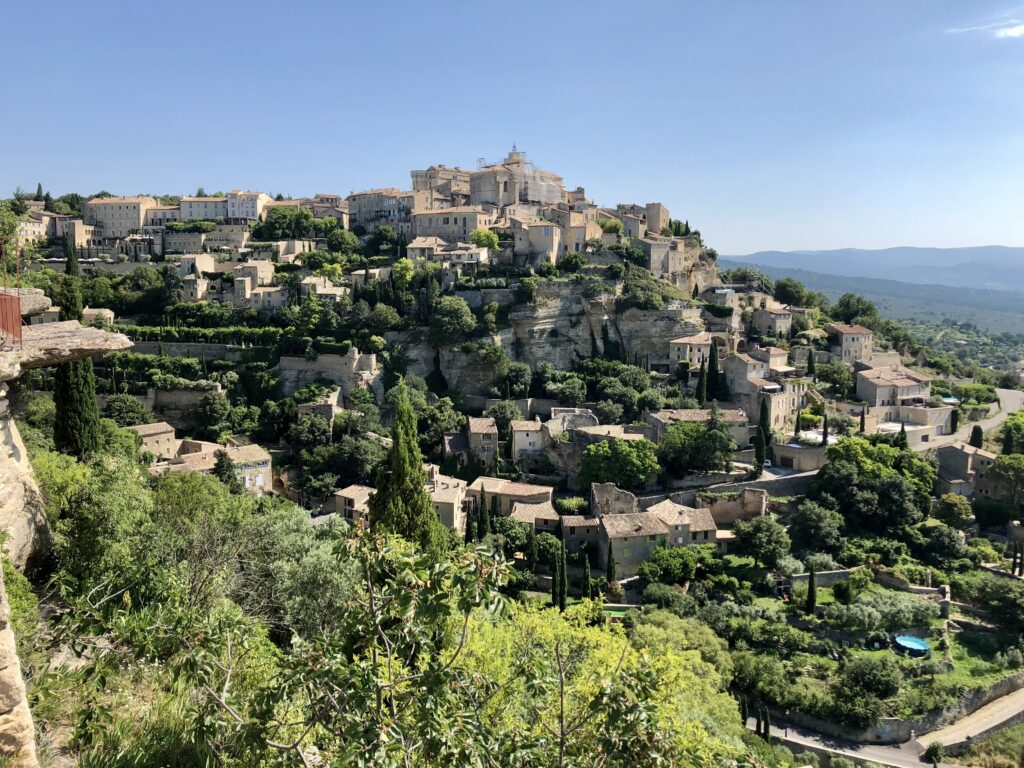
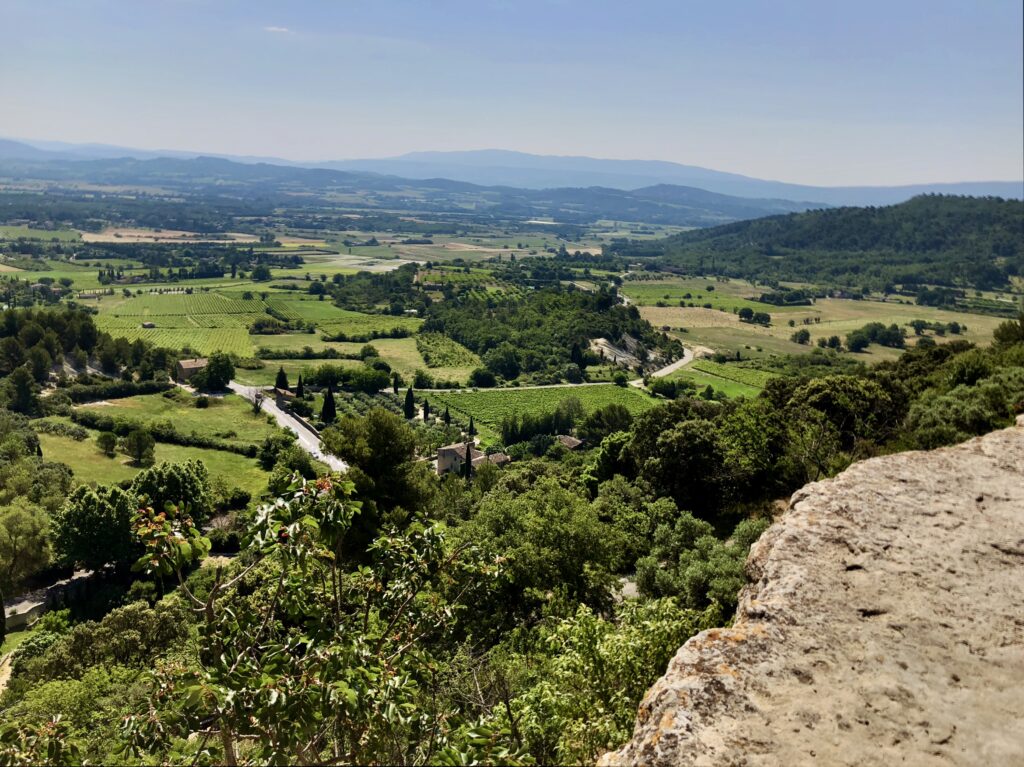
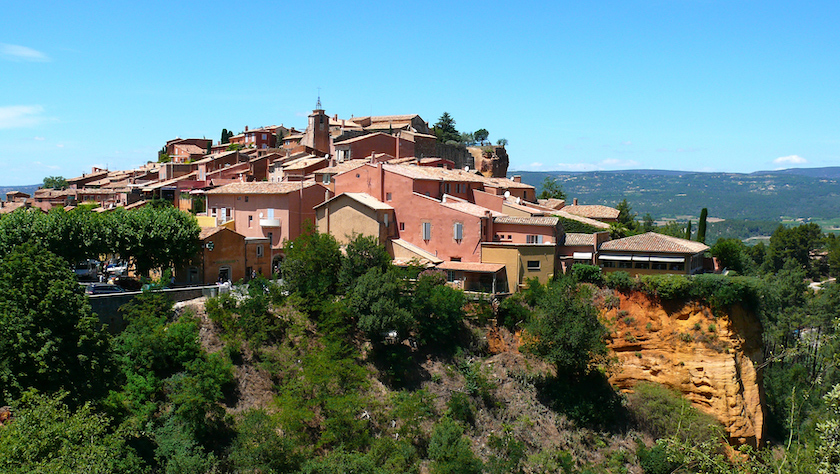
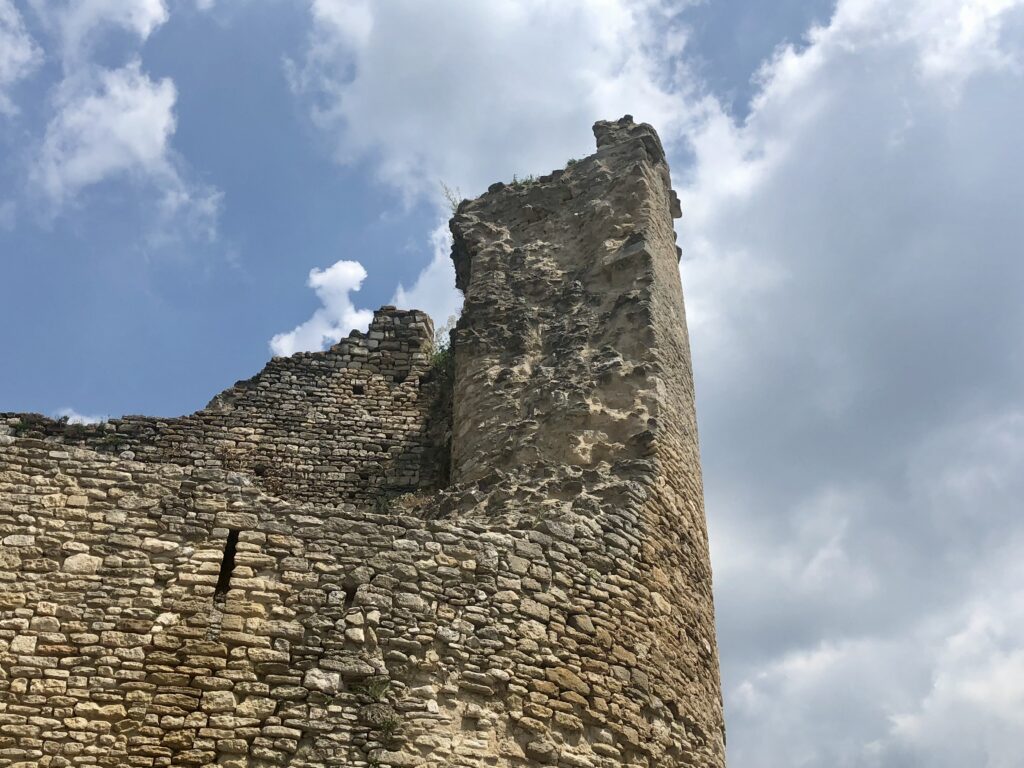
Especially scenic villages in the Luberon include Gordes, with its castle and spectacular overlooks, colorful Roussillon, with its ochre deposits, and Venasque, with its ramparts and Roman towers.
The streets in these fairy-tale-like villages are impossibly narrow; it is hard to imagine how people drive in them.
To illustrate, this photo shows Jeff and our tour guide, Claire, walking down one of the streets in Venasque, side by side. It is far more like a sidewalk than a street. But it is, indeed, a two-way street.
Wandering on foot through these streets, however, is truly a joy.
Many visitors spend multiple days exploring the Luberon area and are able to take advantage of such things as the abundant hiking opportunities and the fine dining. However, if time is limited (and when isn’t it?) in one full day, you can discover and enjoy much about this unique place.
Day 5 – Orange and Châteauneuf-du-Pape
The town of Orange is located 15 miles north of Avignon and can be accessed by a 20-minute train ride.
Roman Orange was founded in 35 BC, and did not become part of France until 1713. It is known for its extraordinary Roman architecture, specifically its amphitheater and its Triumphal Arch, both UNESCO World Heritage Sites.
The Roman Theater of Orange is said to be the best-preserved theater in the world. Its elaborately decorated stage wall stands an impressive 121 feet high and is 338 feet long. King Louis XIV once called it “the finest wall in my kingdom.” Built early in the first century, the theater was abandoned in the year 391. More than 1400 years passed before restoration efforts started in 1825. The theater is now owned by the City of Orange.
Today, the theater is still used, hosting the internationally renowned opera and music festival Chorégies d’Orange every summer; it is the oldest festival in France.
A self-guided audio tour is available to view the theater. In addition, 360-degree virtual-reality headsets are available for a truly immersive experience.
About a 10-minute walk from the theater is the Triumphal Arch, which is believed to have been built between 10 – 25 AD and is 65′ high. It served as the gateway to the Roman city of Arausio. (Now Orange.)
The arch was commissioned as a tribute to the veterans of the Gallic Wars, waged by Julius Caesar. It is covered in intricate carvings of military scenes and weapons of the time.
The Triumphal Arch is considered to be one of the most important relics of the Roman Gaul (present-day France, Belgium, and Luxembourg, along with parts of Switzerland, Germany, the Netherlands, and Italy). Visiting it is free. Some people spend only a few minutes, but it is so captivating, that others spend an hour or more.
After lots of walking and absorbing history, it’s time for an easy (and delicious) afternoon. Catch a taxi (either arranged in advance or at the train station), or book an Uber for the 15-minute ride to the hilltop village of Châteauneuf-du-Pape, home to the world-renowned wine of the same name.
The village overlooks the gorgeous vineyards of the area. The soil here is rocky, dry, and harsh. It seems that’s what makes the amazing grapes. The vines struggle to survive and thus create an unparalleled grape. The famous wines are mostly red, but there are some wonderful whites, as well.
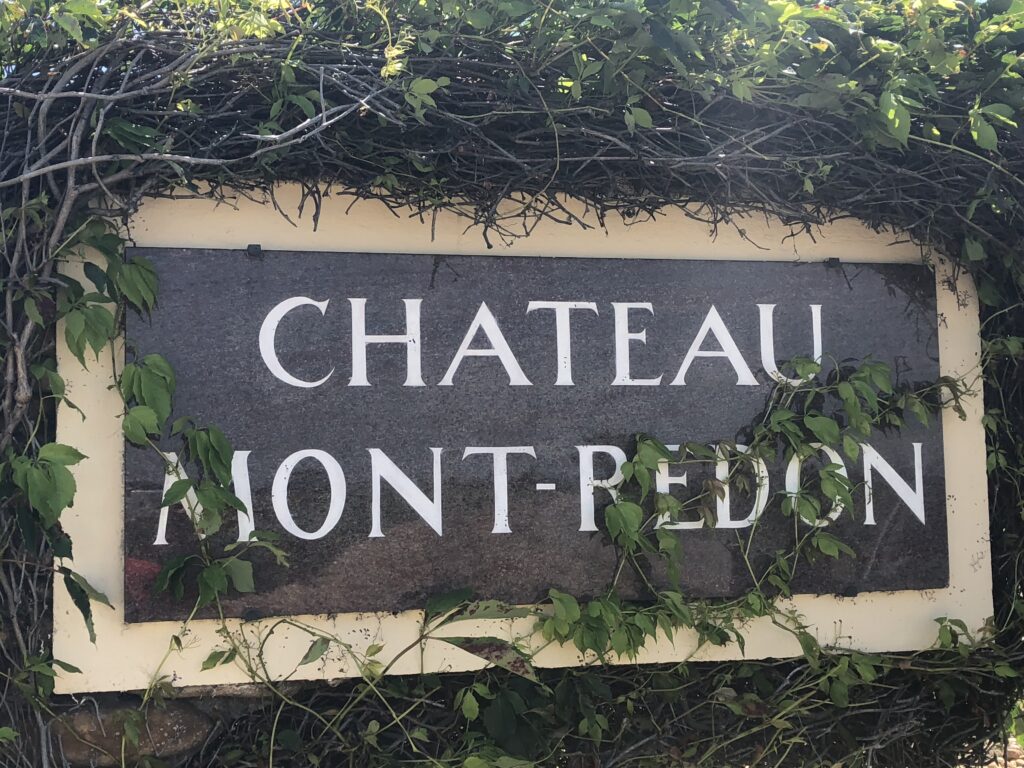
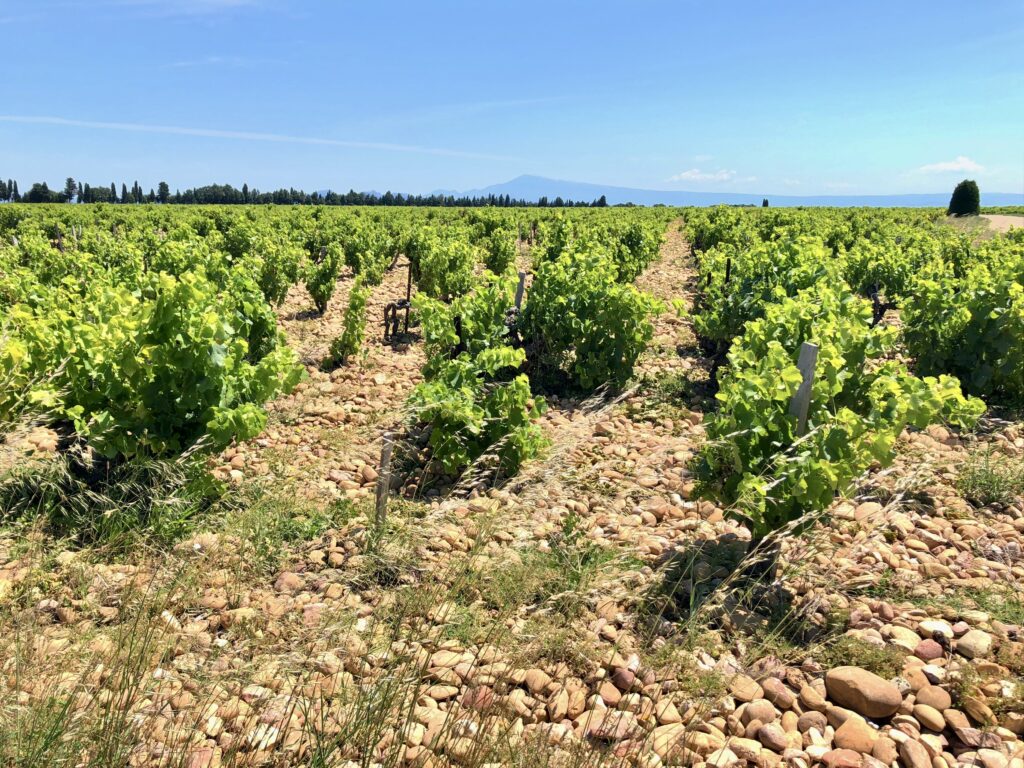
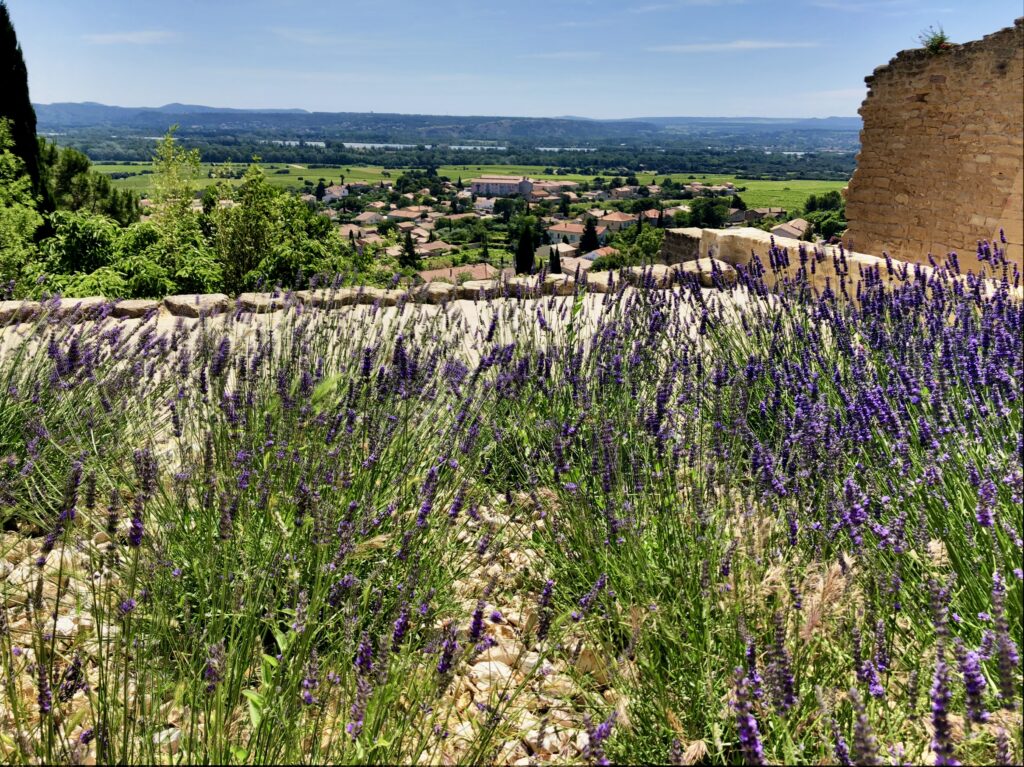

The actual village is small, with only about 2,000 residents. There is a cute main area with numerous restaurants. Choose one with outside seating (if the weather is nice) and enjoy a scenic and tasty lunch with, perhaps, a glass of that famous wine.
Then head up the rather steep hill. (It seems like one is always climbing a steep hill in Provence!)
There are several places in town to taste different varieties of the famed Châteauneuf-du-Pape wines (with a reservation). Les Caves St. Charles is an excellent choice, offering both an impressive setting, at the top of the hill with a large terrace overlooking the vineyards, and an atmospheric wine cave for tasting, as well as an outstanding assortment of some of the best wines available at the time to taste. (They make it easy for you to purchase some and send them back home, should you so choose. A win/win.)
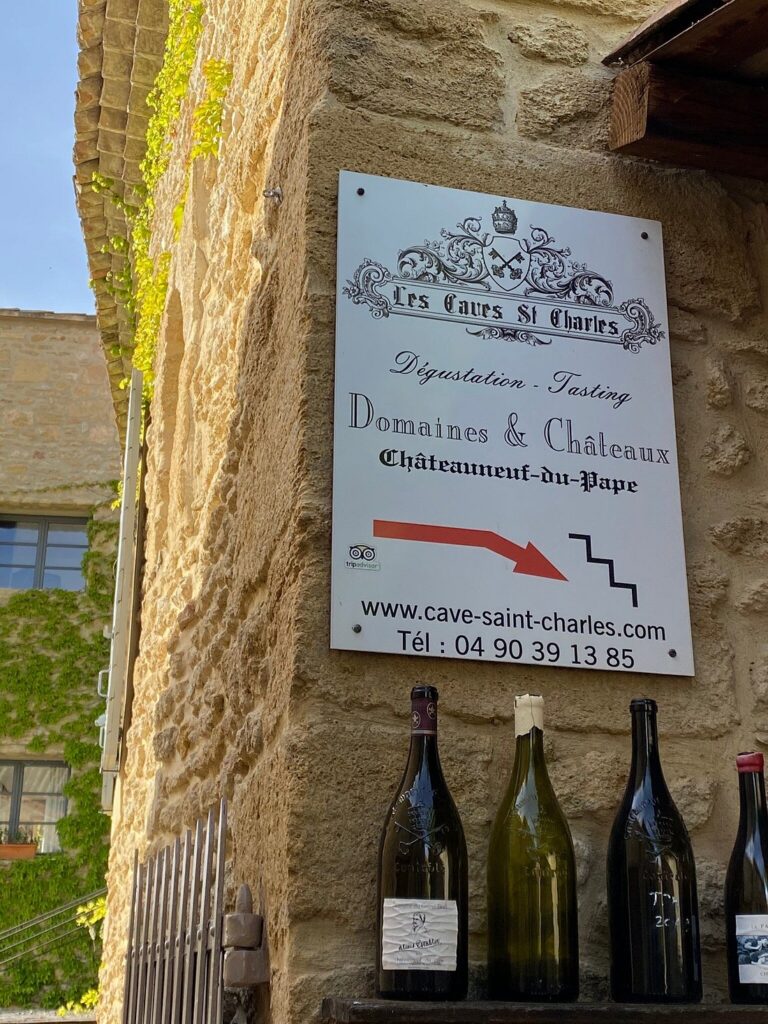
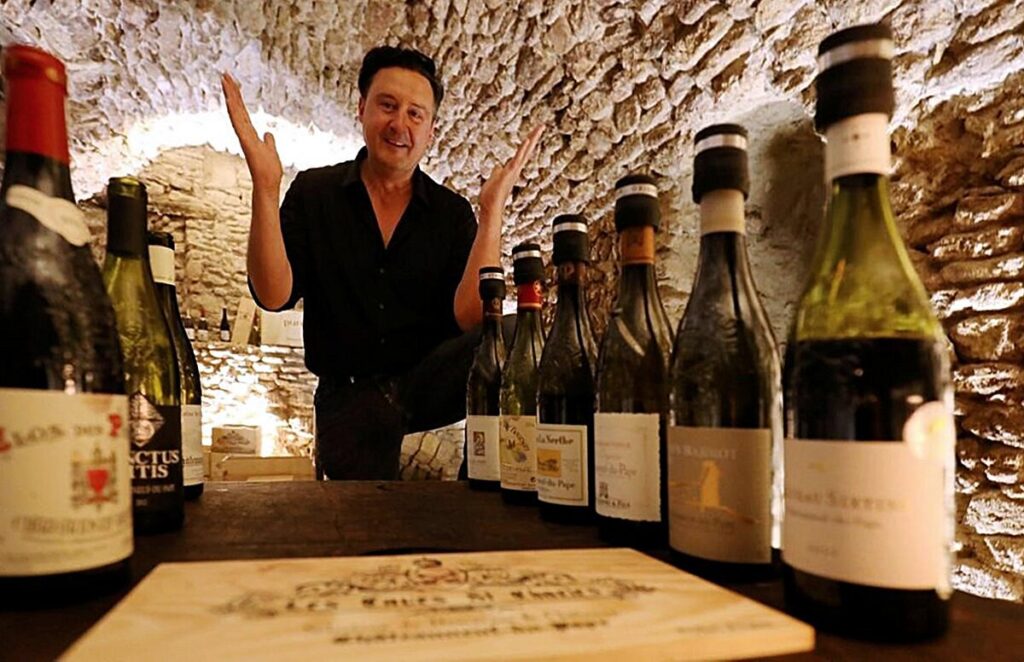
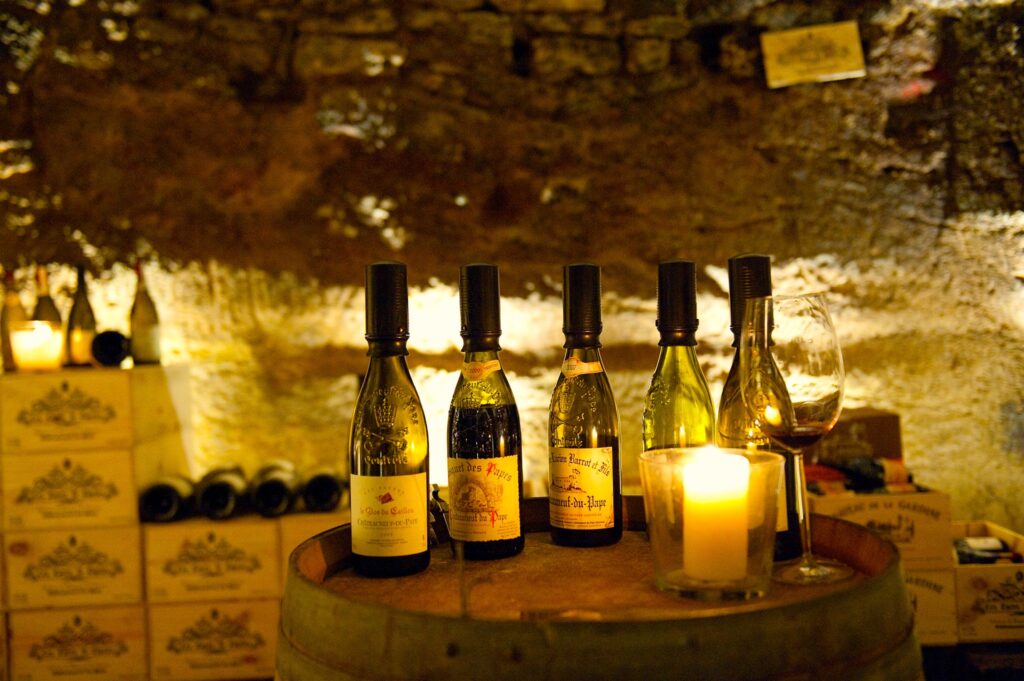
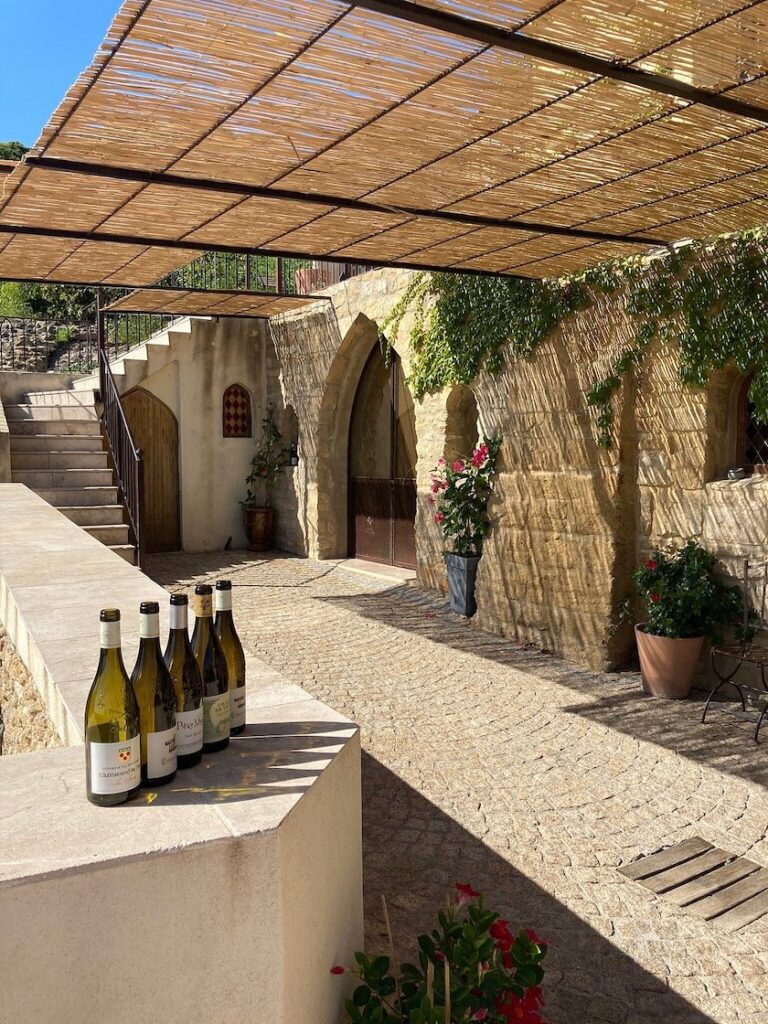
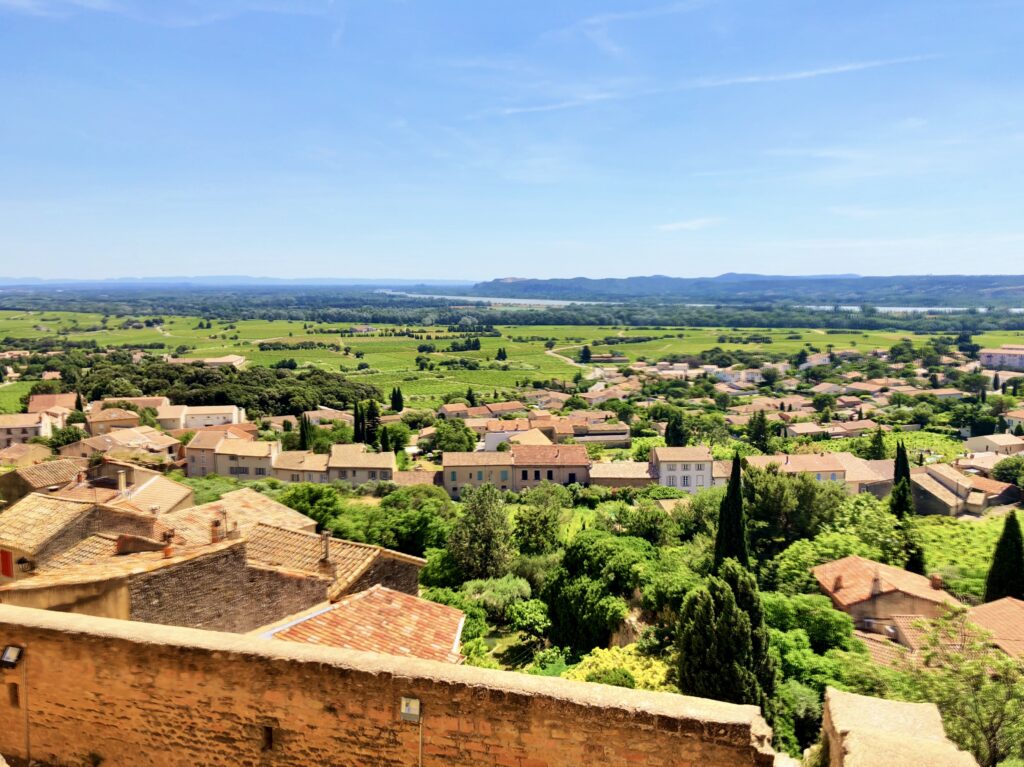
Owner Guy Brémond, or one of his esteemed employees, acts as the sommelier for visitors, educating them about the wines produced in the area, both white and red, as well as the history of wine production in Châteauneuf-du-Pape. The private tasting (of 5-6 different wines by different producers) takes place in an ancient, candle-lit cave. After the tastings, guests are invited to the terrace with wonderful views over the town and the surrounding vineyards. Guy and his crew are welcoming, charming, and entertaining throughout the experience.
Arrange for a taxi or an Uber to return you to Avignon, about a 30-minute ride.
Day 6 – Villeneuve-lès-Avignon
Provence is a popular destination for visitors and is therefore often crowded. But one of the wonderful places that is still a bit under the radar is Villeneuve-lès-Avignon, translating to “new Avignon”. It is the town the famous bridge, the Pont d’Avignon, was built to access, right across the Rhône River from Avignon.
On the advice of two different locals, we decided to visit, seeking a calm, uncrowded day. One of the locals suggested we take a cab, and the other said we could easily walk, so we chose to walk. 25,000 steps later, returning to Avignon, we wondered if we’d made the best choice. But of course, the journey is part of the destination. Taking a cab or bus in one direction and walking the other would also be a great option.
In whatever manner you get there, Villeneuve-lès-Avignon is absolutely worth the trip.
Tour Philippe-le-Bel (Tower of Philippe the Fair). The tower is beautifully located right on the Rhône, at what used to be the other side of the Pont d’Avignon.
The tower and adjacent buildings, finished in 1302, are named after French King Philippe-le-Bel (Philip the Fair), who founded the town of Villeneuve-lès-Avignon. Philip had the tower strategically built to warn the French residents of impending attacks from the Romans across the river (or elsewhere).
The Pont d’Avignon was abandoned in 1669, (see information in Day 1 – Avignon post), rendering the fortress useless. It was allowed to fall into disrepair, and much of it was demolished by the early 1800s. But in 1862, the tower was listed as a historic monument and has remained open to the public ever since.
At the top of the staircase, there is a little window with a great view. Many might assume that is all. But look closely – there is a tiny door with a message in French, roughly translated to: “Don’t let the pigeons in”. Carefully open the door, duck through it, and voila! There is a large, walkable area, just below the bell, with fabulous views in all directions.

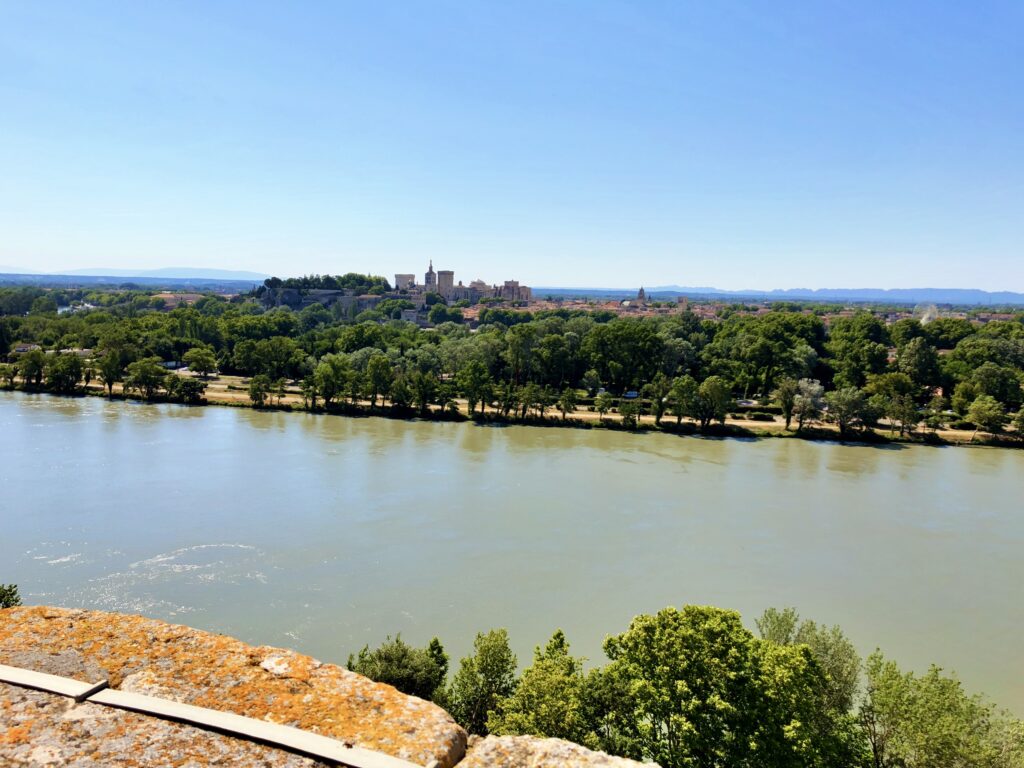
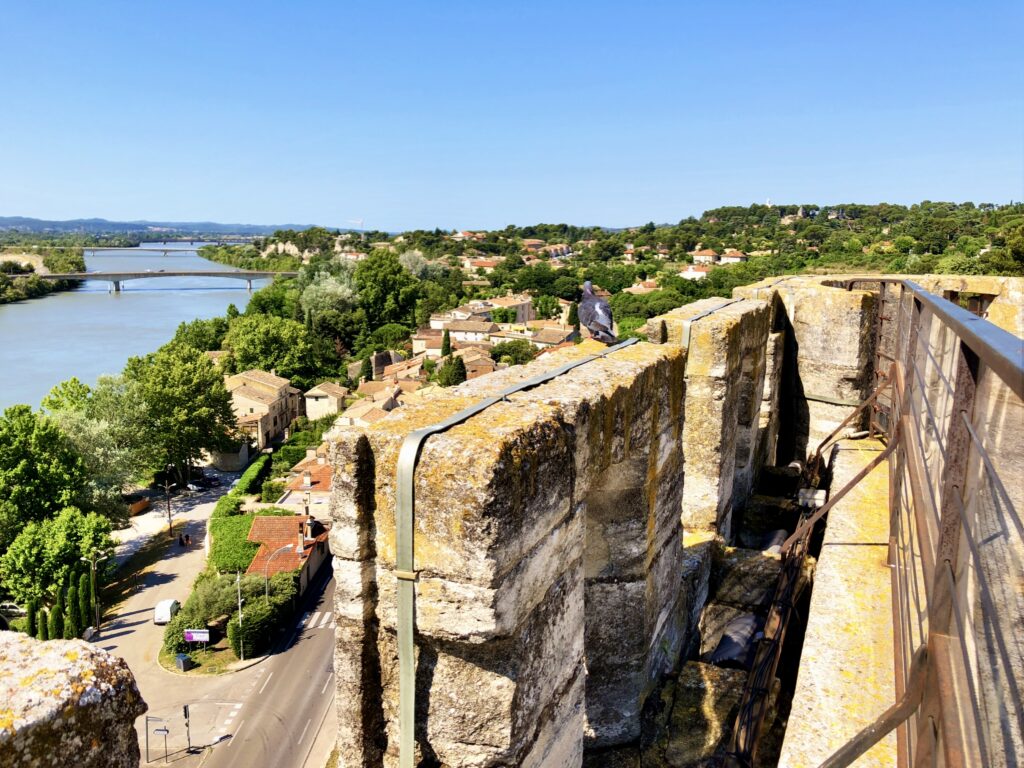

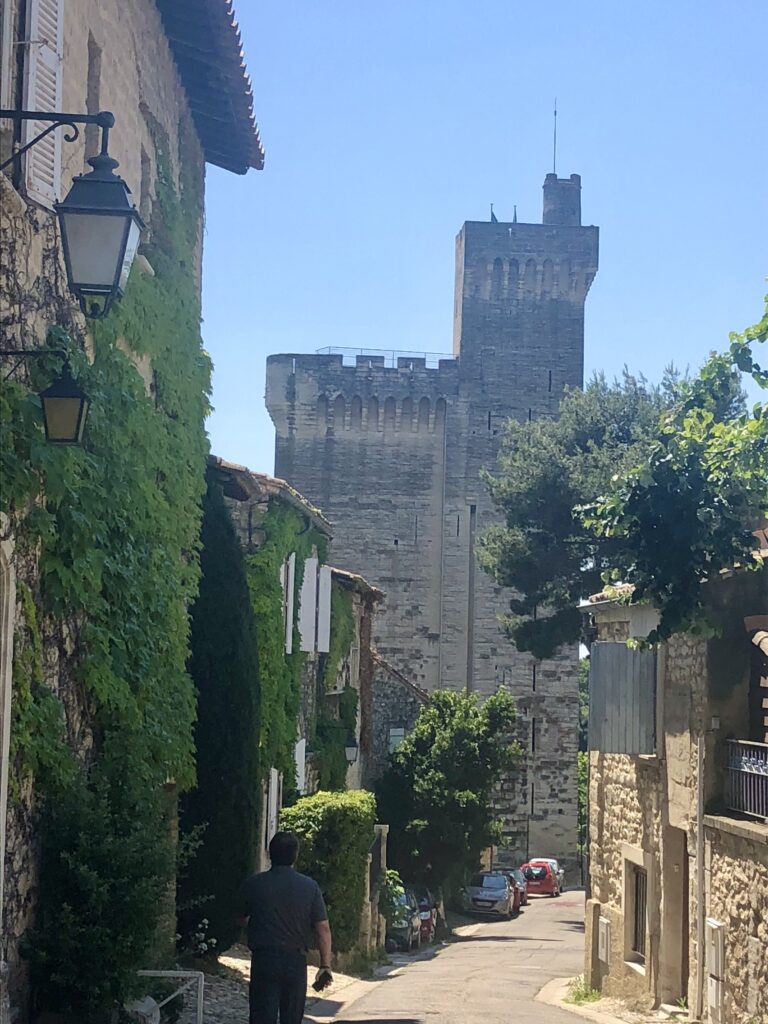
About a 15-minute walk (uphill) from the Tower is Fort Saint-André. This construction of this magnificent medieval fortress was commissioned by French King Philip IV, (the same “Philip the Fair” for whom the tower, above, is named.) He negotiated with the Benedictine Abbey of Saint-André, which owned land on a plateau, the highest spot in the area, and overlooking Avignon, on which to build.
In the mid-1300s, the fortress was finally constructed by then-king John II (John the Good), and it provided defense to the town and surrounding area of the west bank of the Rhône against Avignon, which sought to control both banks. In return for the land, the abbey was provided protection.
In 1481, Provence once again became part of France, and a fort was no longer necessary. Nevertheless, Fort Saint-André was maintained by the French military for another 300 years. It was then abandoned until 1906, when it was designated a historic monument.
In a self-guided tour of the Fort, visitors can view the royal château, called the “twin towers”, the Tour des Masques, with ancient stone markings from soldiers and prisoners, and the Romanesque Belvezet Chapel, as well as the fortification walls. From the towers and walkways, magnificent views over the town, as well as Avignon, the Rhône valley, and Mont-Vento.
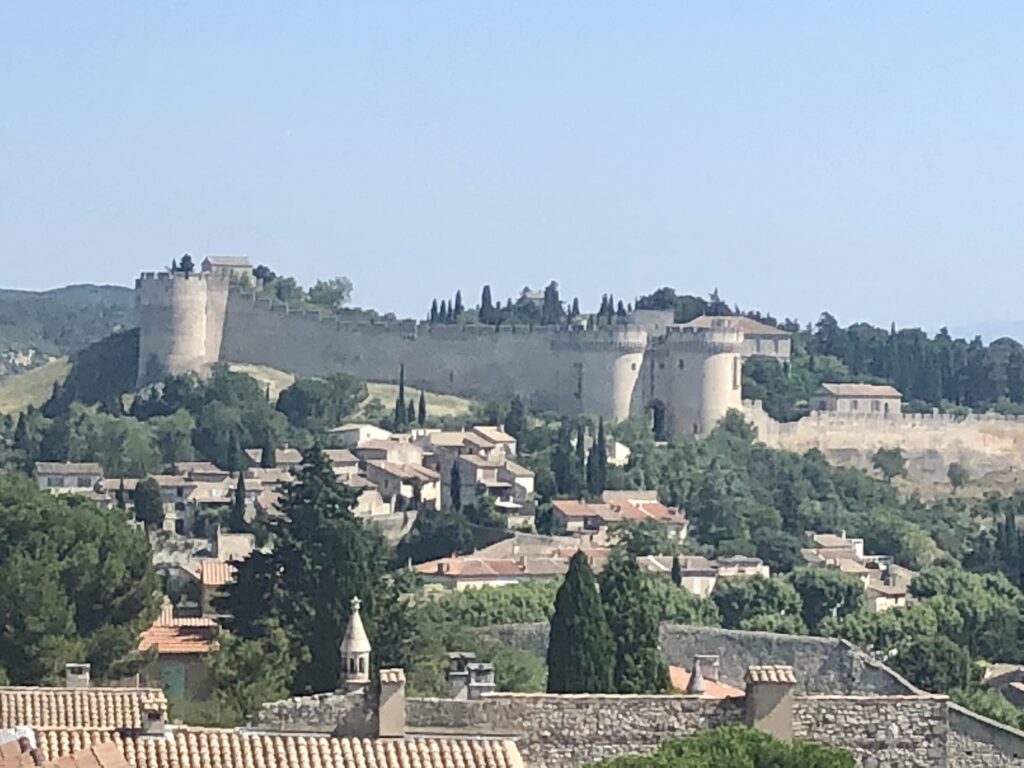
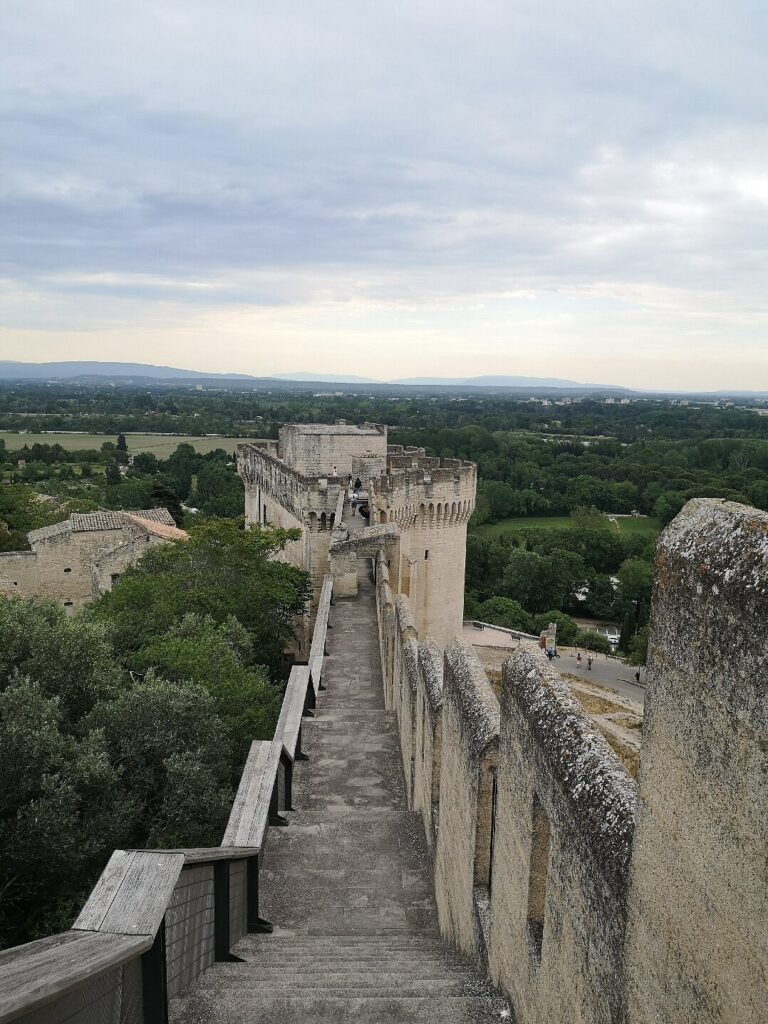
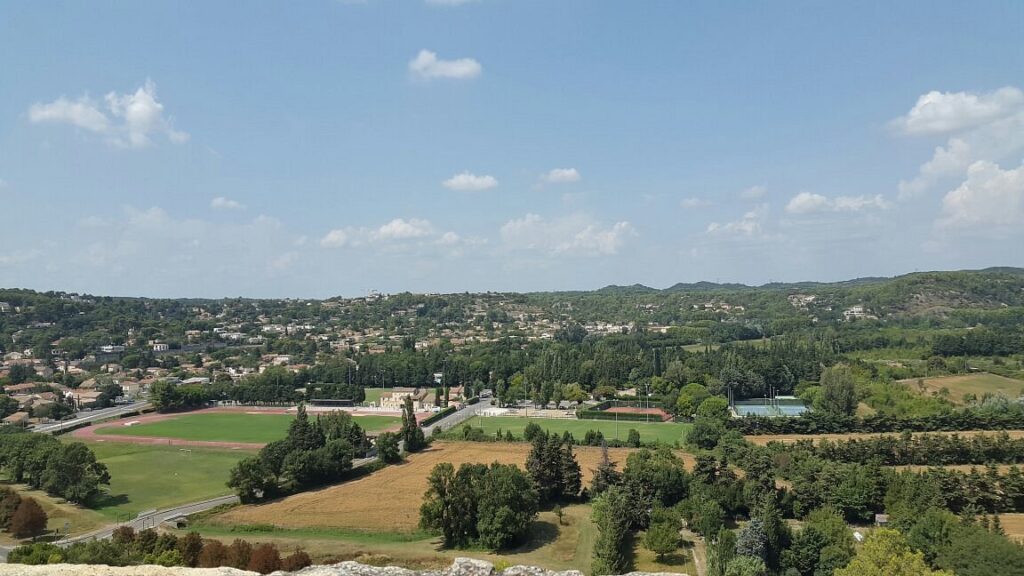
The lovely gardens, located within the walls of the Fort, are designed in Tuscan, Mediterranean, and Provençal styles and include paths, fountains, and terraces.
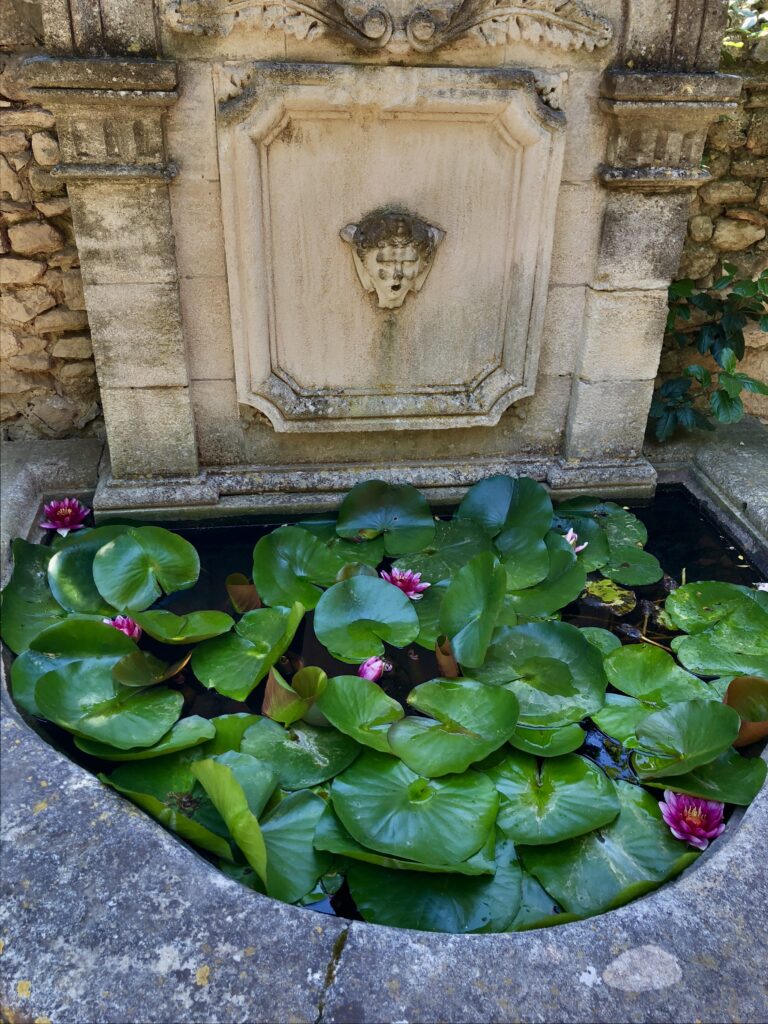

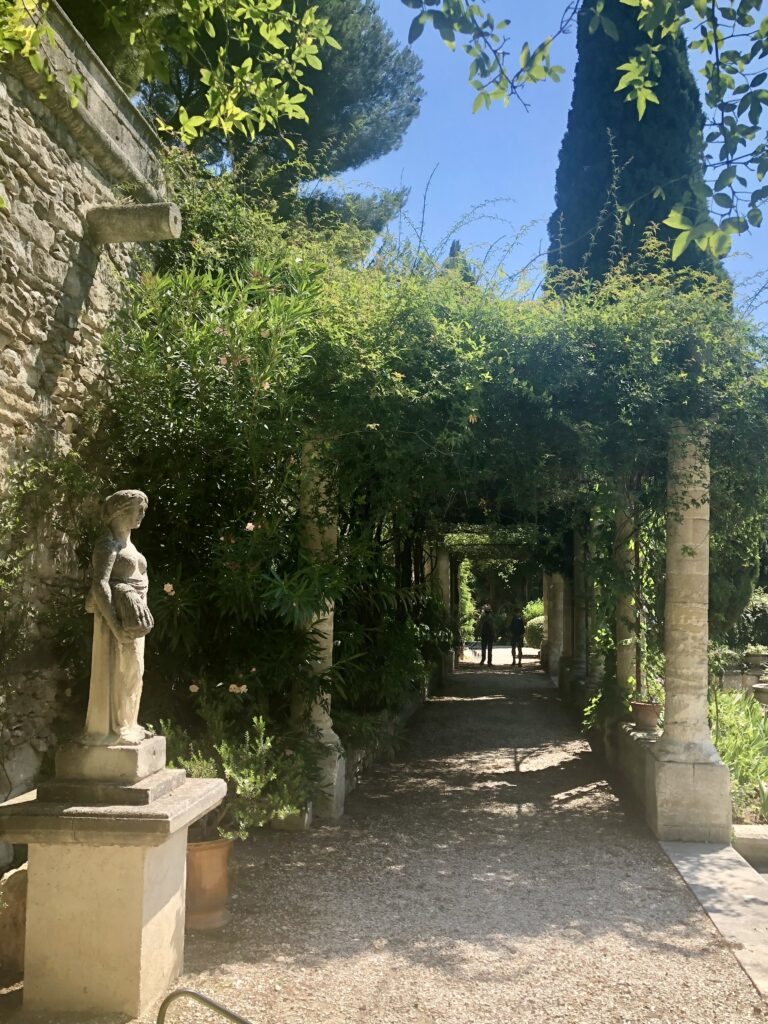
Not far from the Fort is the charming main town square, Place Jean Jaurès. Filled with cute cafés, it is an excellent place for a late lunch or refreshment.
A 5-minute walk from the town square is Chartreuse du Val-de-Bénédiction, a sprawling 14th-century monastery, founded by Pope Innocent VI.
After undergoing extensive renovations in the 20th century, the monastery is now open to the public. Highlights include the chapel frescoes by Matteo Giovannetti, who also painted the frescoes in the Palace of the Popes in Avignon, the mausoleum of Pope Innocent VI, cloisters, monk’s cells, and multiple gardens.
The monk’s cells are sometimes occupied by artists in residence, generally playwrights and authors, as it is the home of the Centre National des Ecritures du Spectacle (National Centre for Script Writing).
The peaceful and uncrowded site includes a café, a restaurant, and a bookstore.
On the route back down toward the Rhône, and toward Avignon, is the small but delightful park, Jardin Georges Pompidou. Its relaxing, manicured, largely shaded paths lead visitors through an interesting array of Mediterranean flowers and plants and a huge natural stone wall that borders the park. There are even cacti growing out of the stone wall. The park also features fun, whimsical sculptures, and is a perfect way to end the day.
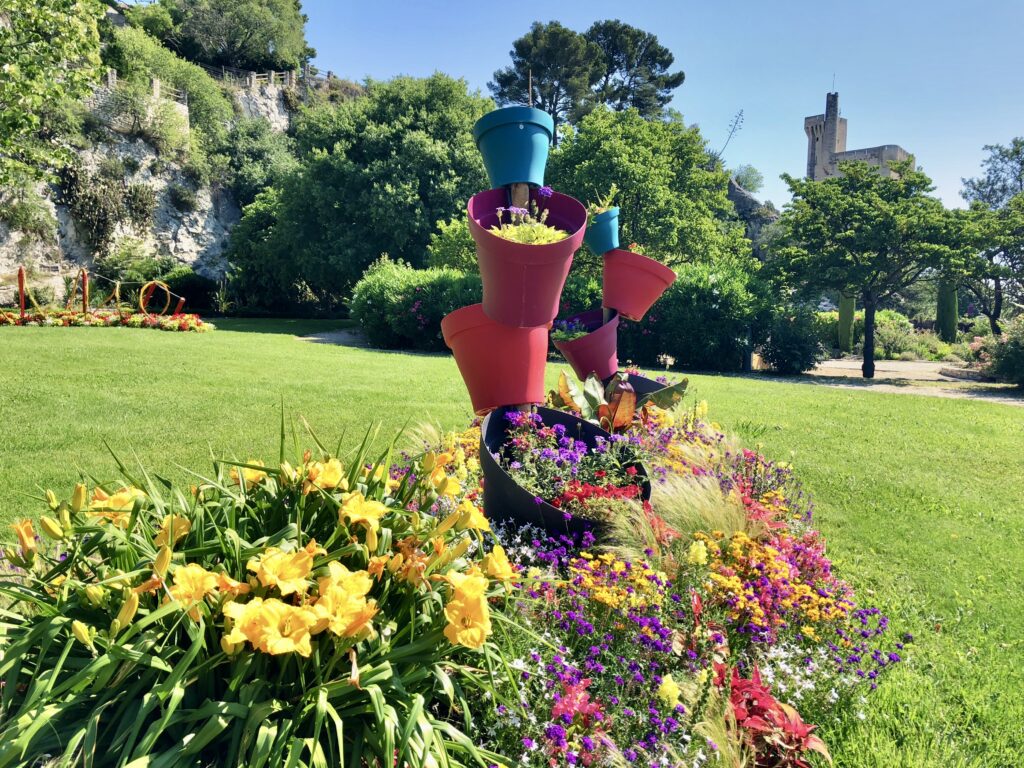
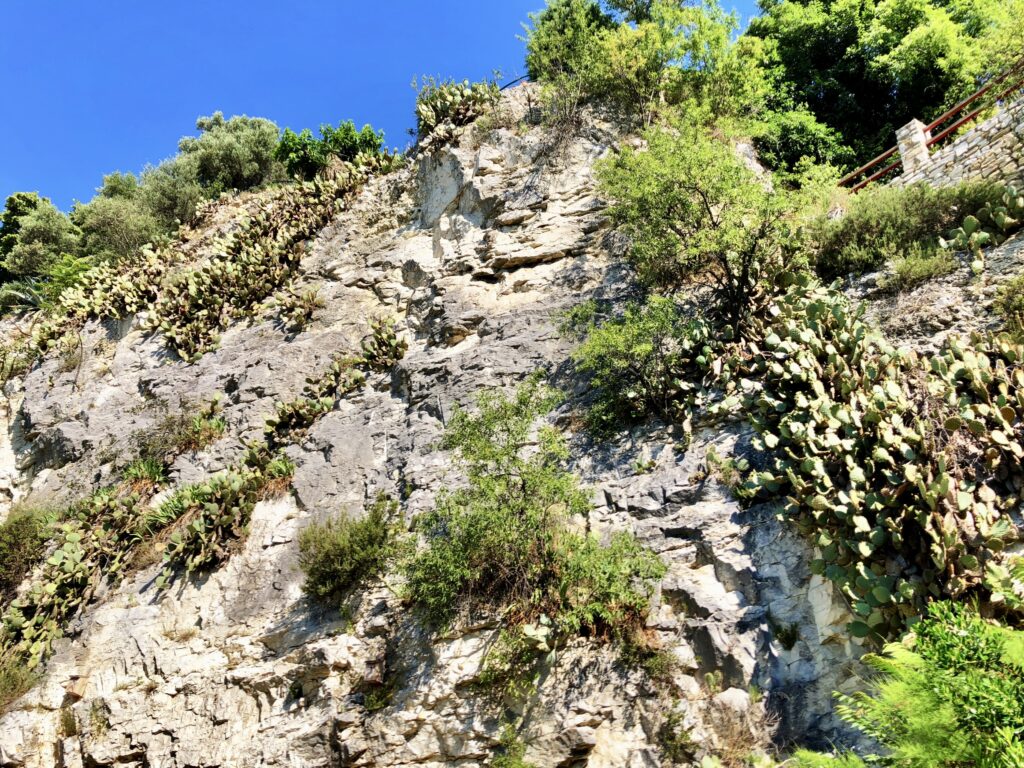
Eating in Avignon
It would take some effort to not eat well in Avignon, or Provence in general. Avignon has an abundance of casual but high-quality restaurants, most with lovely patios. Favorites include:
Restaurant L’Epicerie – Tucked away in a quiet courtyard with excellent salads and traditional French food.
Le Goût du Jour – (Meaning “taste of the day”) Warm and friendly restaurant with an innovative menu that changes daily.
O’Papilles – Cozy location with seasonal menu, beautifully presented. It has unusually large portions for France.
Fou de Fafa – Outstanding traditional French restaurant owned by a fun, entertaining couple. A meal to remember!
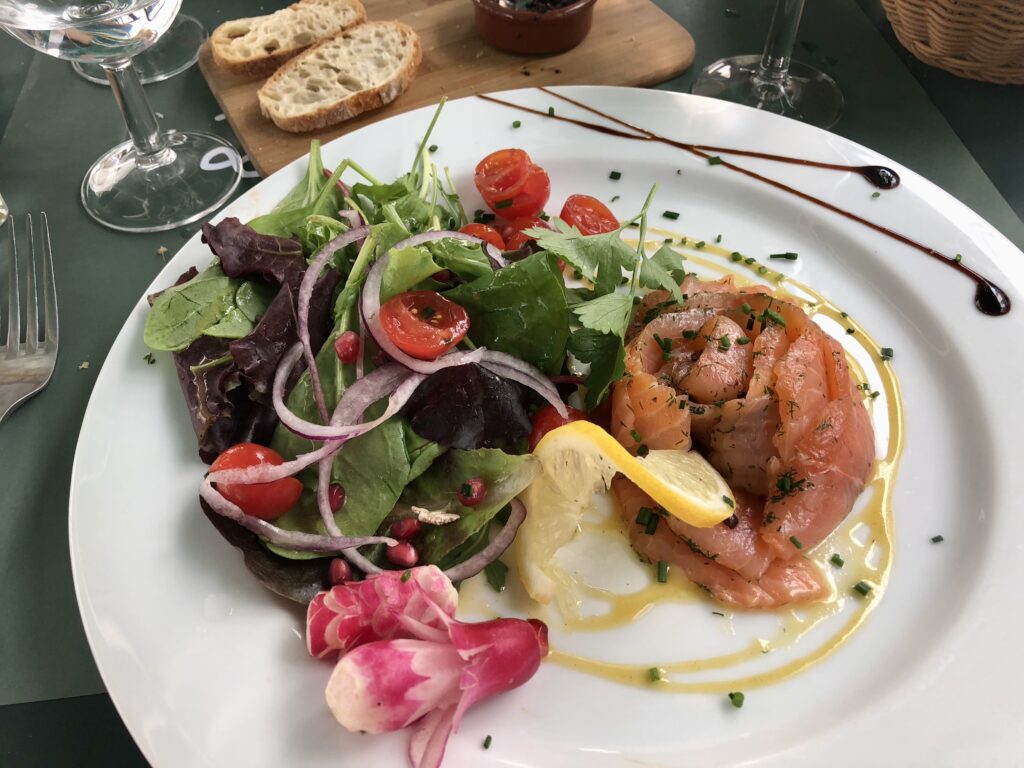
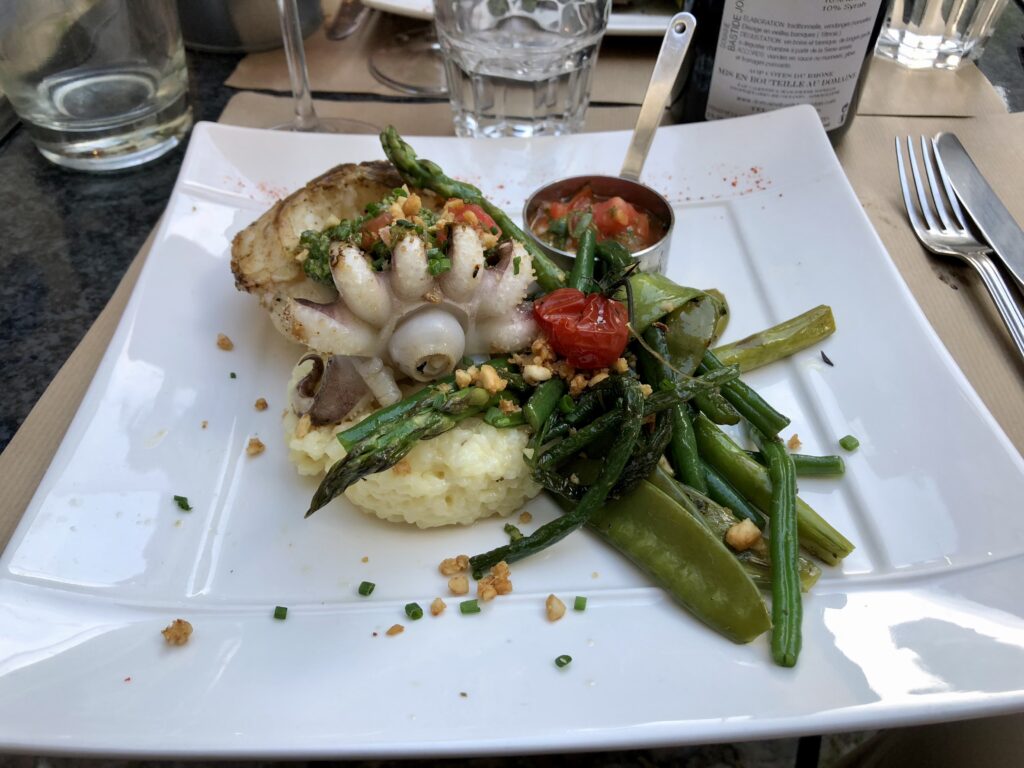
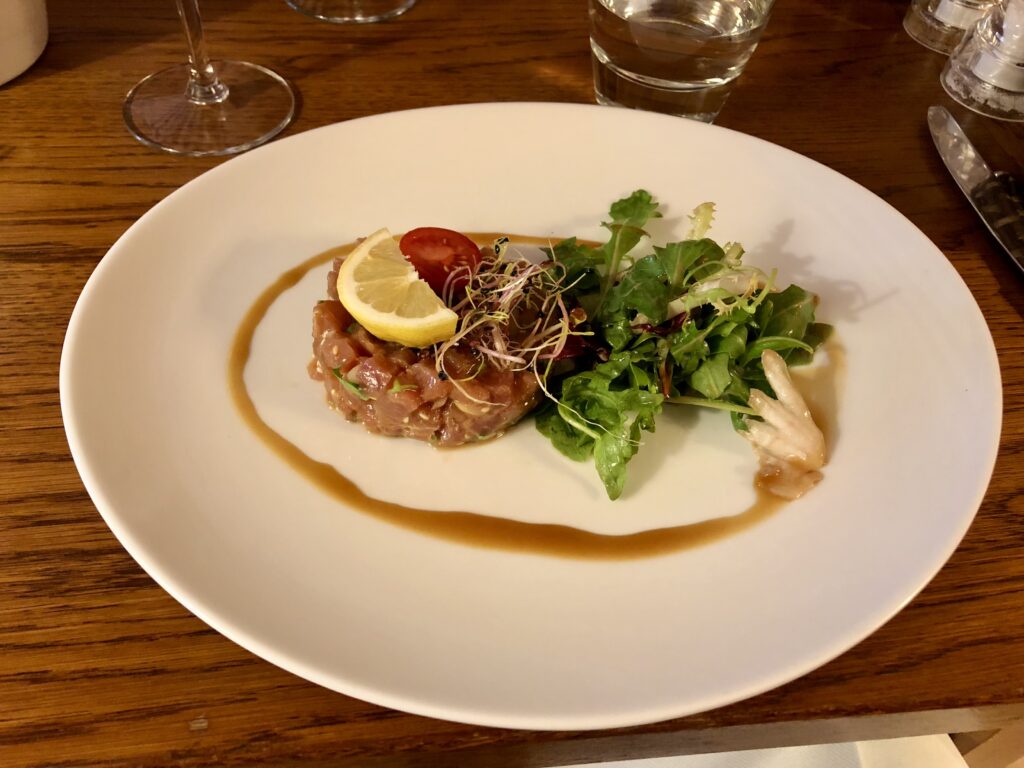
This is merely a taste of Provence. 6 days is not nearly enough to cover the whole region! But 6 days provide enough to have a “feel” for Provence; it is unlike the rest of France. And 6 days will surely leave you longing for more.
Where to Stay in Avignon
We highly recommend staying in Avignon’s historic center. You will be near scores of restaurants, most of the main sites of the city, lots of shopping opportunities, and the train station.
Are you continuing your in France? Check out our articles about Bordeaux, Lyon, and repeat visits to Paris.
Discover more from Werthwhile Wandering
Subscribe to get the latest posts sent to your email.

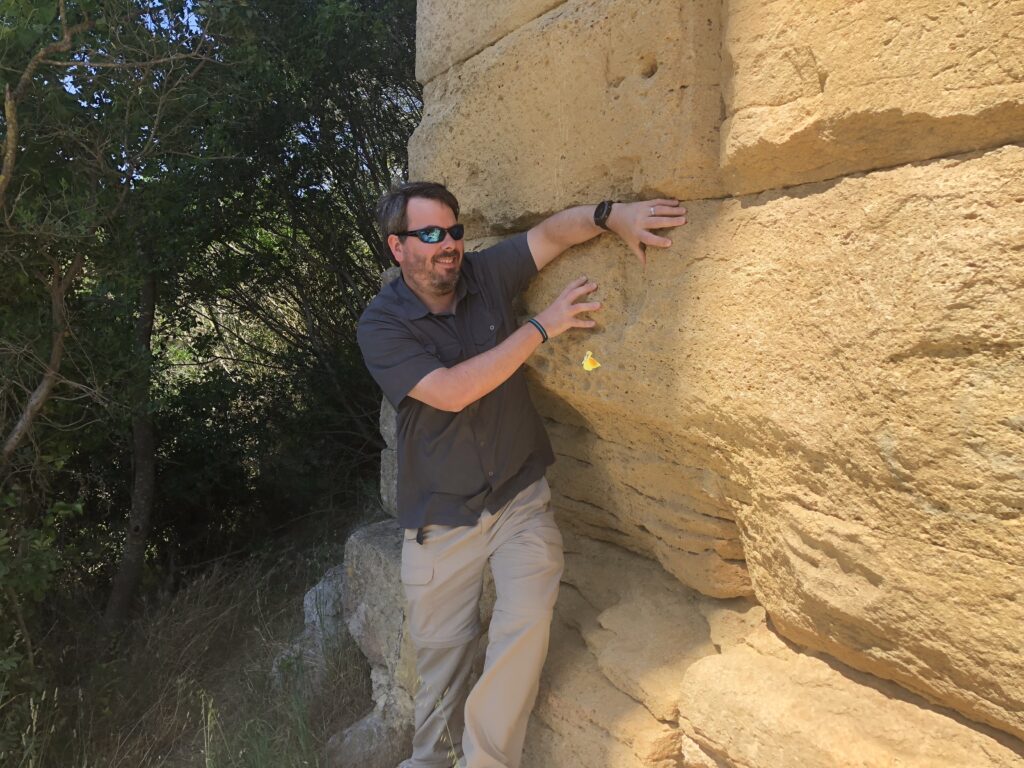
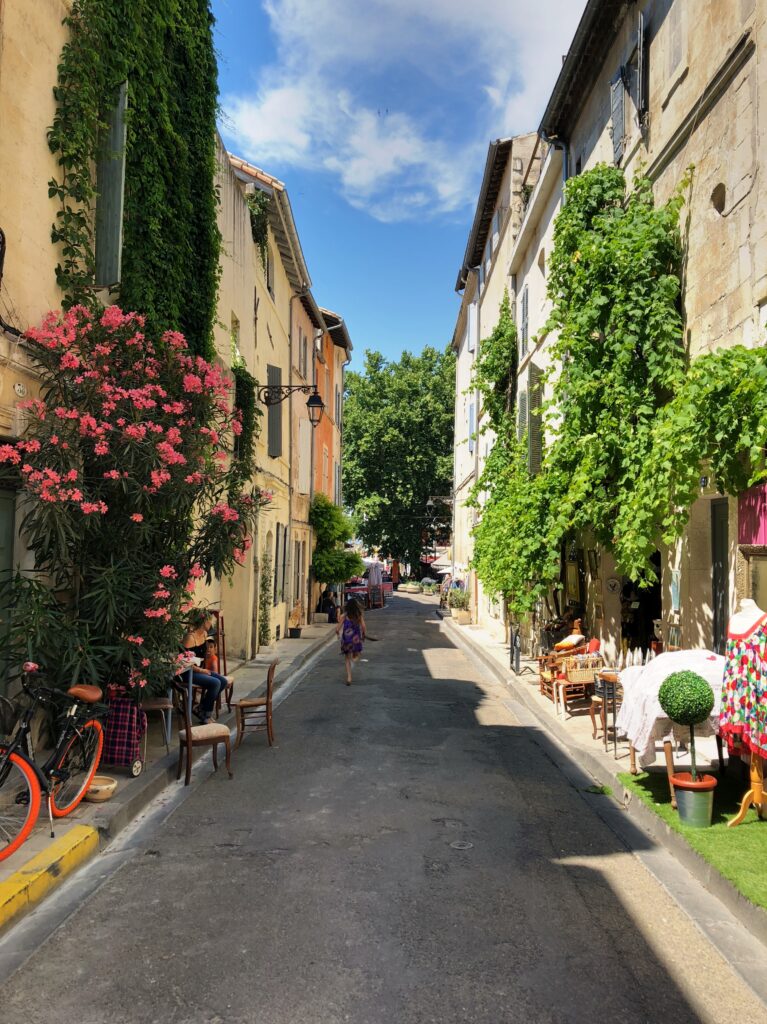
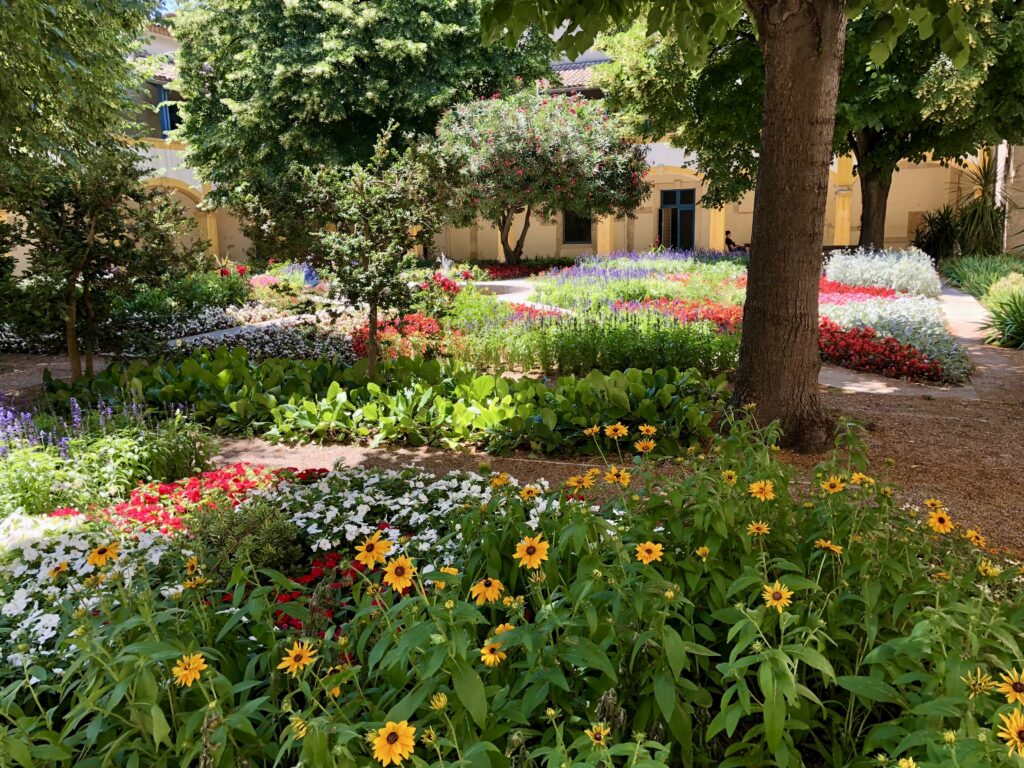
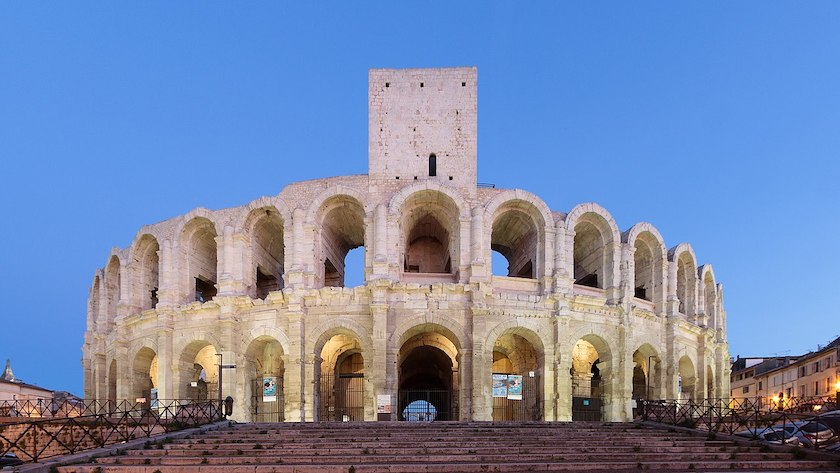

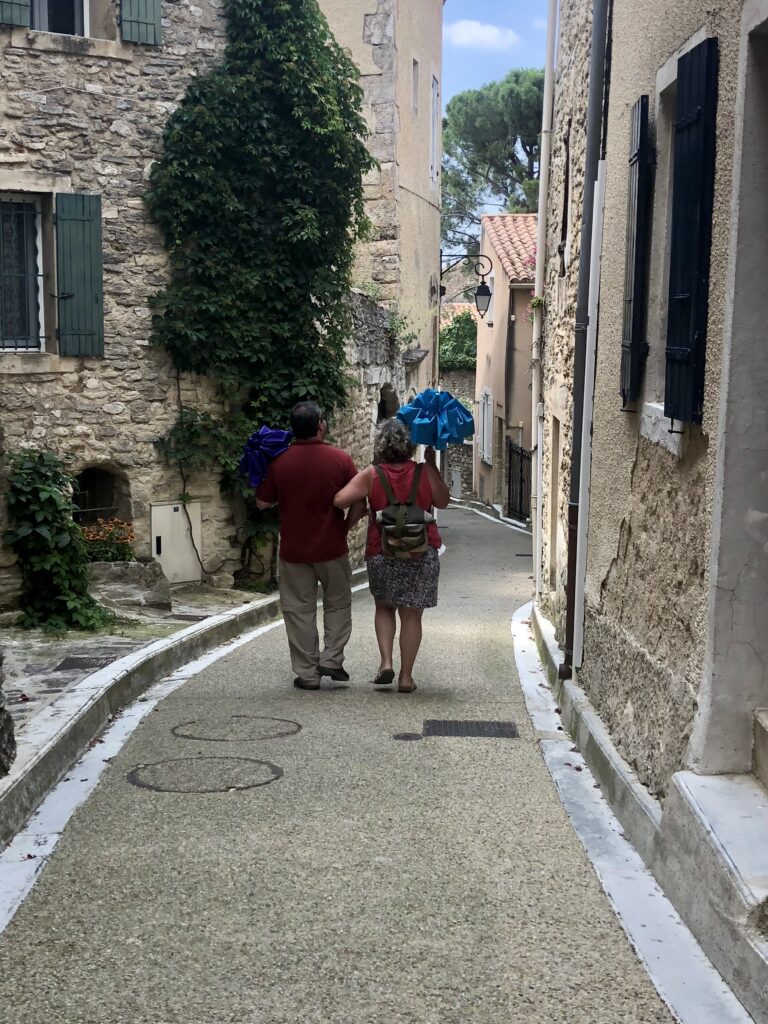
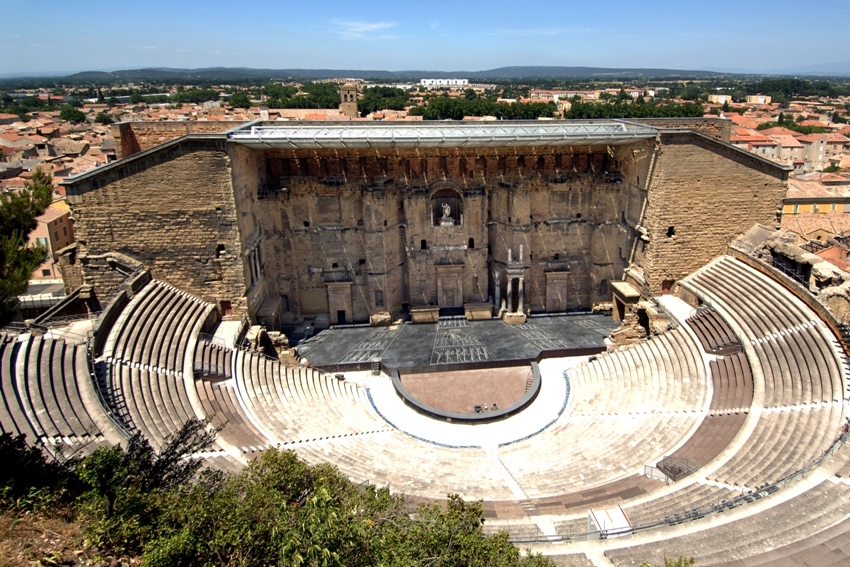
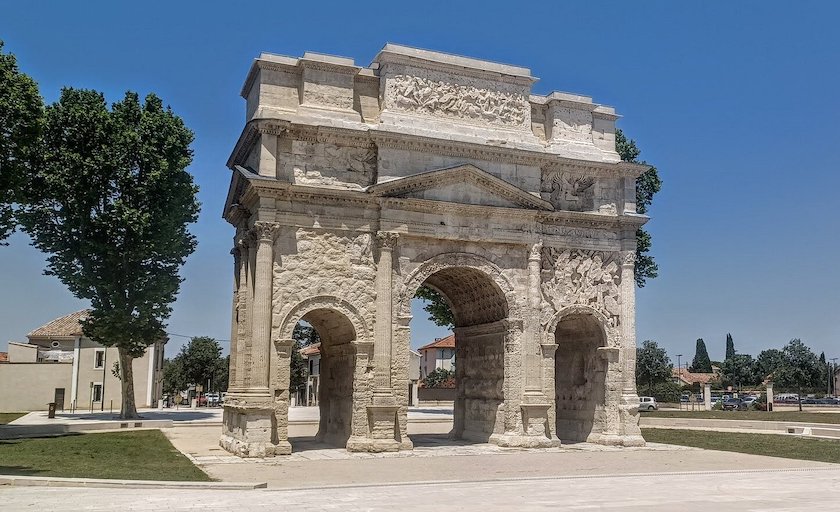
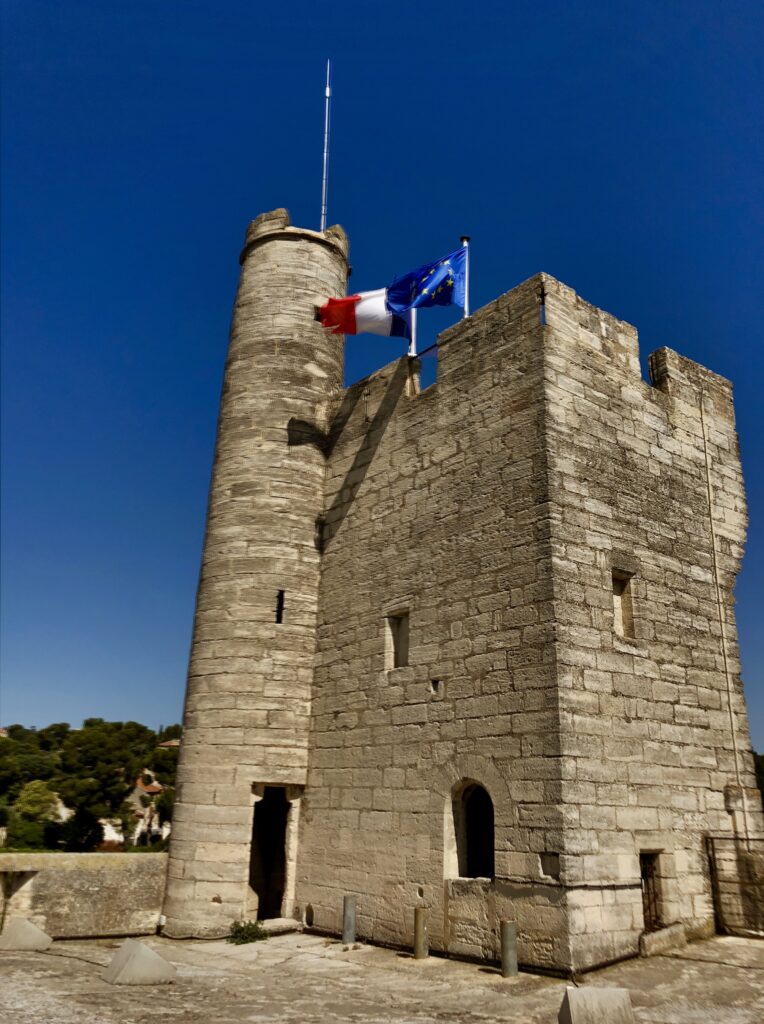
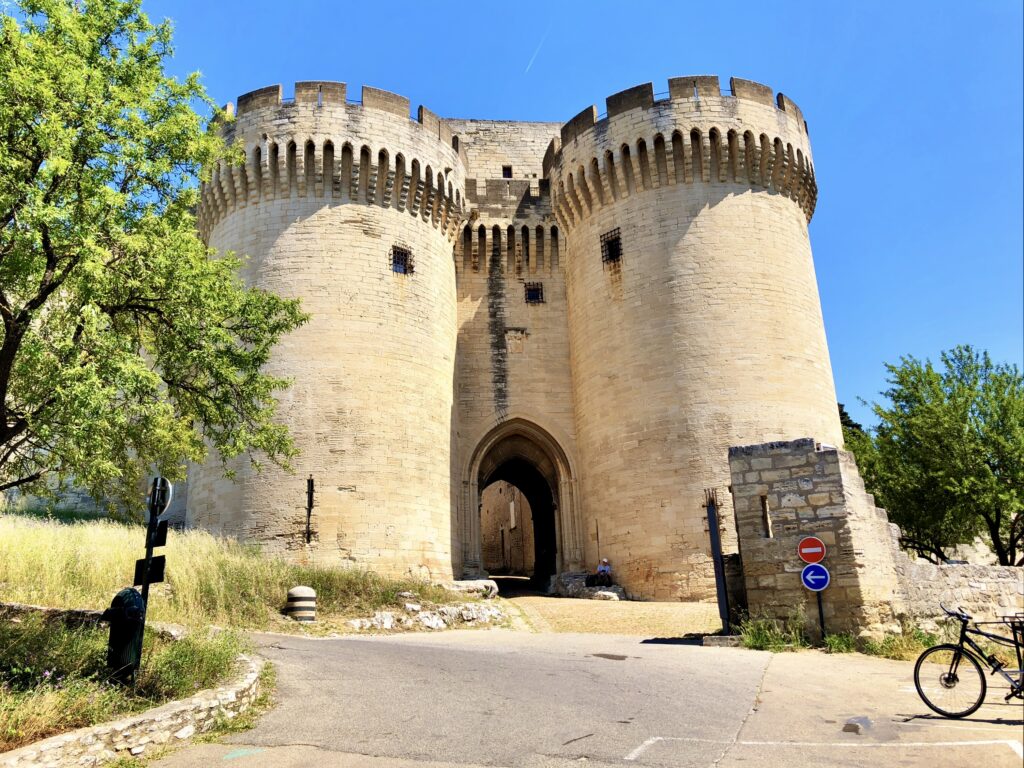
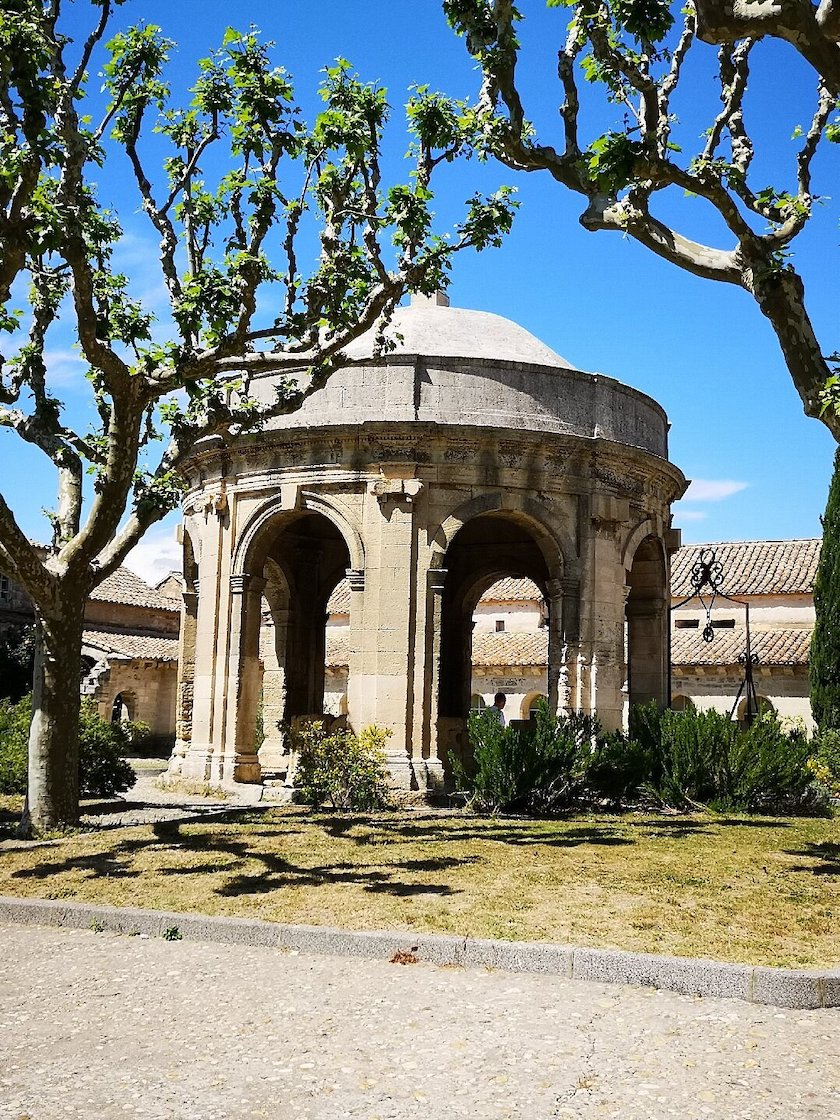
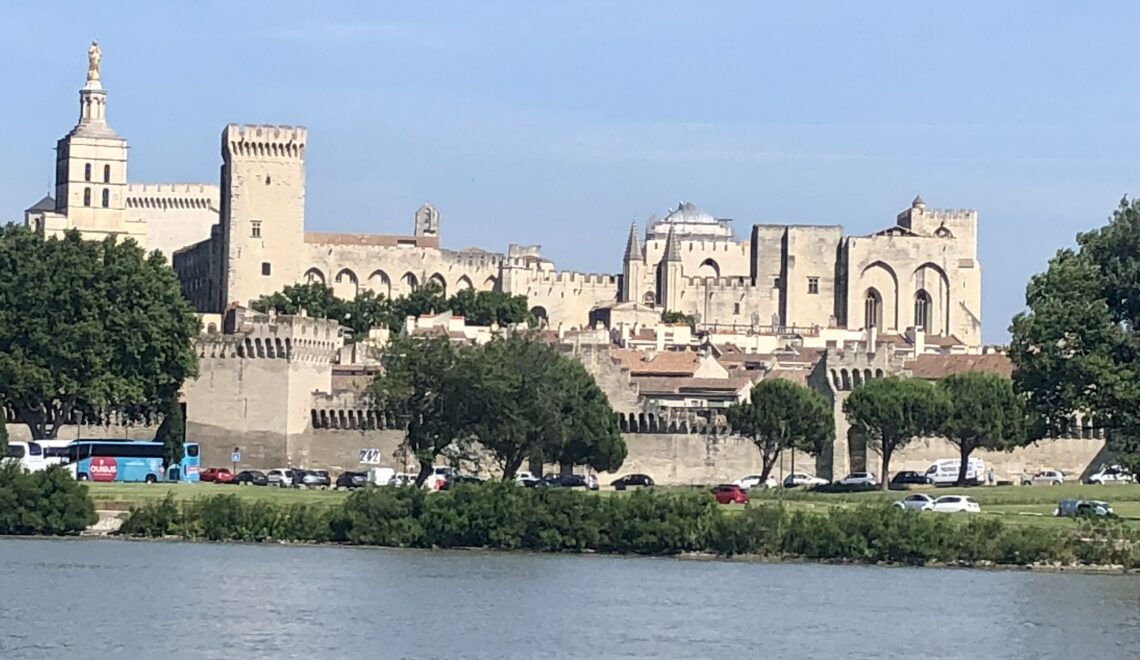




This looks fun. But how was the weather? Was it super hot and windy like I’ve read? I’m not sure I’d want to go then, lol.
Hi Anna! We were there in June and there were several days it was above 90 degrees. There were also a couple of days that it was REALLY windy. The famous Mistral winds. But it honestly didn’t impact us very much. We just dressed in cool clothing (it’s very casual there, and shorts are just fine). And I always had a hair tie! To see the lavender, you do have to go during the hotter months of June or July.
Thanks for reading!
I spent a week in southern France several years ago, bu it obviously wasn’t enough. I want to go back soon and see all those things I missed! Thanks for all the wonderful suggestions!!
Thank you, Cindy! We, too, hope to return soon to see all we missed, including Marseille. It is a stunning area.
This was such a magic place!
It is, indeed!
Lover Peter Mayle’s books (RIP) and want to live in Provence!